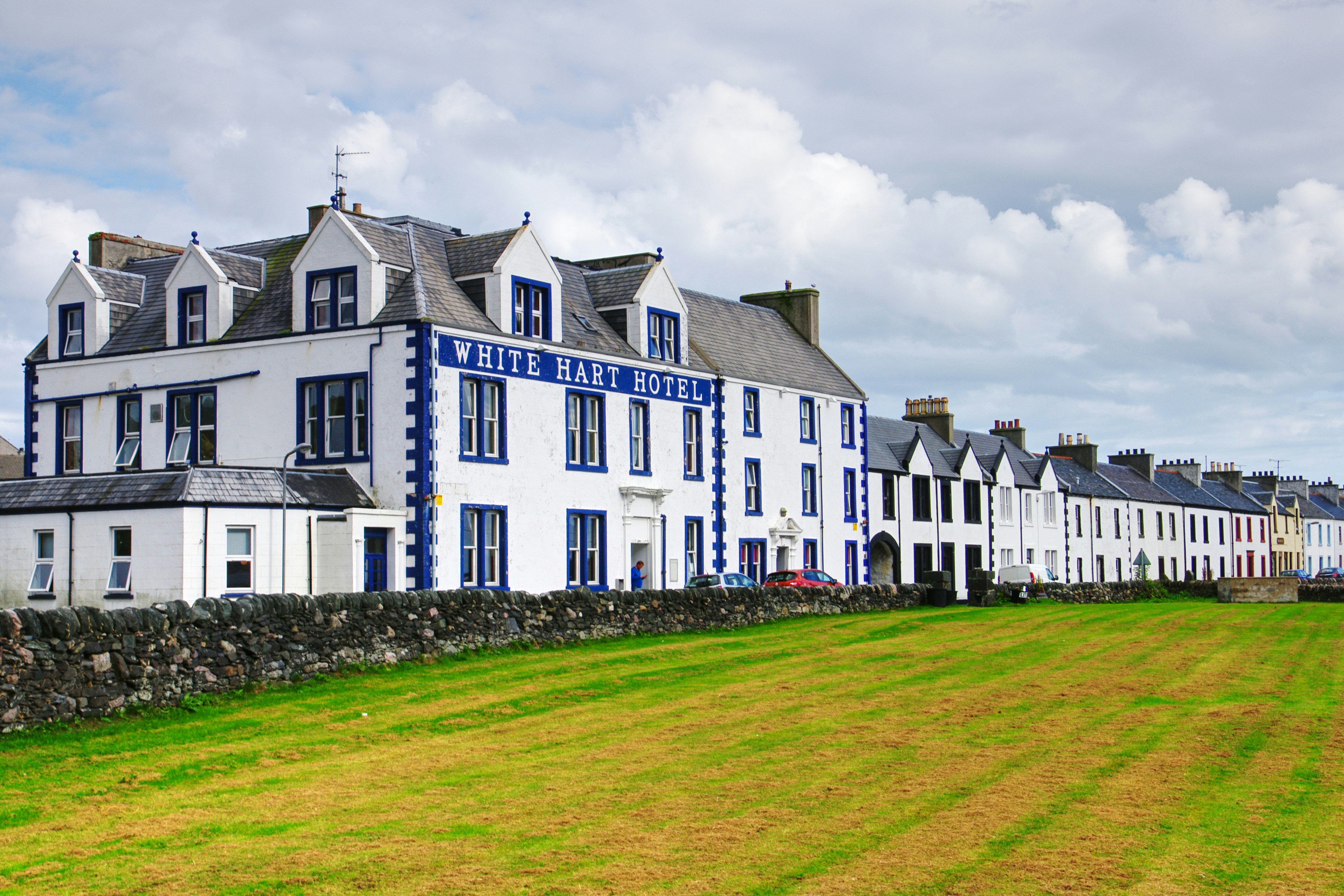
Celtic Homelands
Celtic Homelands
Cruise overview
WHY BOOK WITH US?
- ✔ The Deluxe Cruises’ team has extensive experience in ultra-luxury cruising.
- ✔ Call now to speak to our helpful and experienced Cruise Concierge team.
- ✔ Enjoy our Unique Deluxe Cruises Bonus for substantial savings.
- ✔ Our team will tailor your holiday to your exacting requirements.
- ✔ As agents, we work under the protection of each cruise lines ABTA / ATOL licences
About Troon

About Port Ellen, Isle of Islay

About Portrush
Portrush is adjacent to the stunning North Antrim coastline. Here lies the medieval Dunluce Castle ruins. Perched picturesquely at the edge of a rocky outcropping high above the sea, the castle is dramatically surrounded by terrifyingly steep drops, which the early Christians and Vikings would have considered a very important security feature. The castle and surrounding areas have been frequently used for the filming of “Game of Thrones”. Another attraction reached from Portrush is the Giant’s Causeway -40,000 hexagonal basalt columns that descend in a kind of pathway to the sea. Formed over 50 million years ago, visitors have marvelled at its majesty and mystery for centuries, and UNESCO has recognised this site with World Heritage status.

About Belfast
Before English and Scottish settlers arrived in the 1600s, Belfast was a tiny village called Béal Feirste ("sandbank ford") belonging to Ulster's ancient O'Neill clan. With the advent of the Plantation period (when settlers arrived in the 1600s), Sir Arthur Chichester, from Devon in southwestern England, received the city from the English Crown, and his son was made Earl of Donegall. Huguenots fleeing persecution from France settled near here, bringing their valuable linen-work skills. In the 18th century, Belfast underwent a phenomenal expansion—its population doubled every 10 years, despite an ever-present sectarian divide. Although the Anglican gentry despised the Presbyterian artisans—who, in turn, distrusted the native Catholics—Belfast's growth continued at a dizzying speed. The city was a great Victorian success story, an industrial boomtown whose prosperity was built on trade, especially linen and shipbuilding. Famously (or infamously), the Titanic was built here, giving Belfast, for a time, the nickname "Titanic Town." Having laid the foundation stone of the city's university in 1845, Queen Victoria returned to Belfast in 1849 (she is recalled in the names of buildings, streets, bars, monuments, and other places around the city), and in the same year, the university opened under the name Queen's College. Nearly 40 years later, in 1888, Victoria granted Belfast its city charter. Today its population is nearly 300,000, tourist numbers have increased, and this dramatically transformed city is enjoying an unparalleled renaissance.This is all a welcome change from the period when news about Belfast meant reports about "the Troubles." Since the 1994 ceasefire, Northern Ireland's capital city has benefited from major hotel investment, gentrified quaysides (or strands), a sophisticated new performing arts center, and major initiatives to boost tourism. Although the 1996 bombing of offices at Canary Wharf in London disrupted the 1994 peace agreement, the ceasefire was officially reestablished on July 20, 1997, and this embattled city began its quest for a newfound identity.Since 2008, the city has restored all its major public buildings such as museums, churches, theaters, City Hall, Ulster Hall—and even the glorious Crown Bar—spending millions of pounds on its built heritage. A gaol that at the height of the Troubles held some of the most notorious murderers involved in paramilitary violence is now a major visitor attraction.Belfast's city center is made up of three roughly contiguous areas that are easy to navigate on foot. From the south end to the north, it's about an hour's leisurely walk.
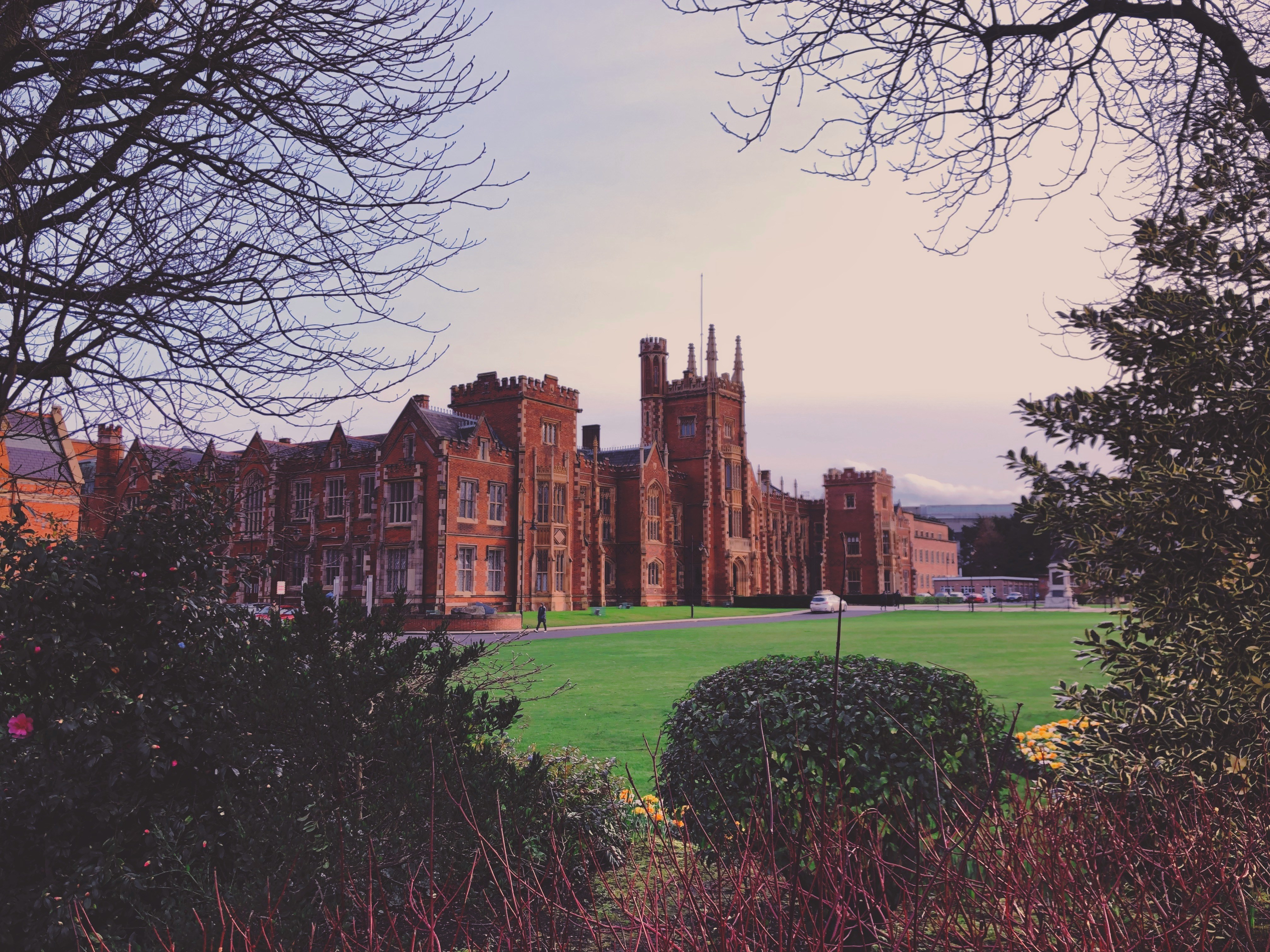
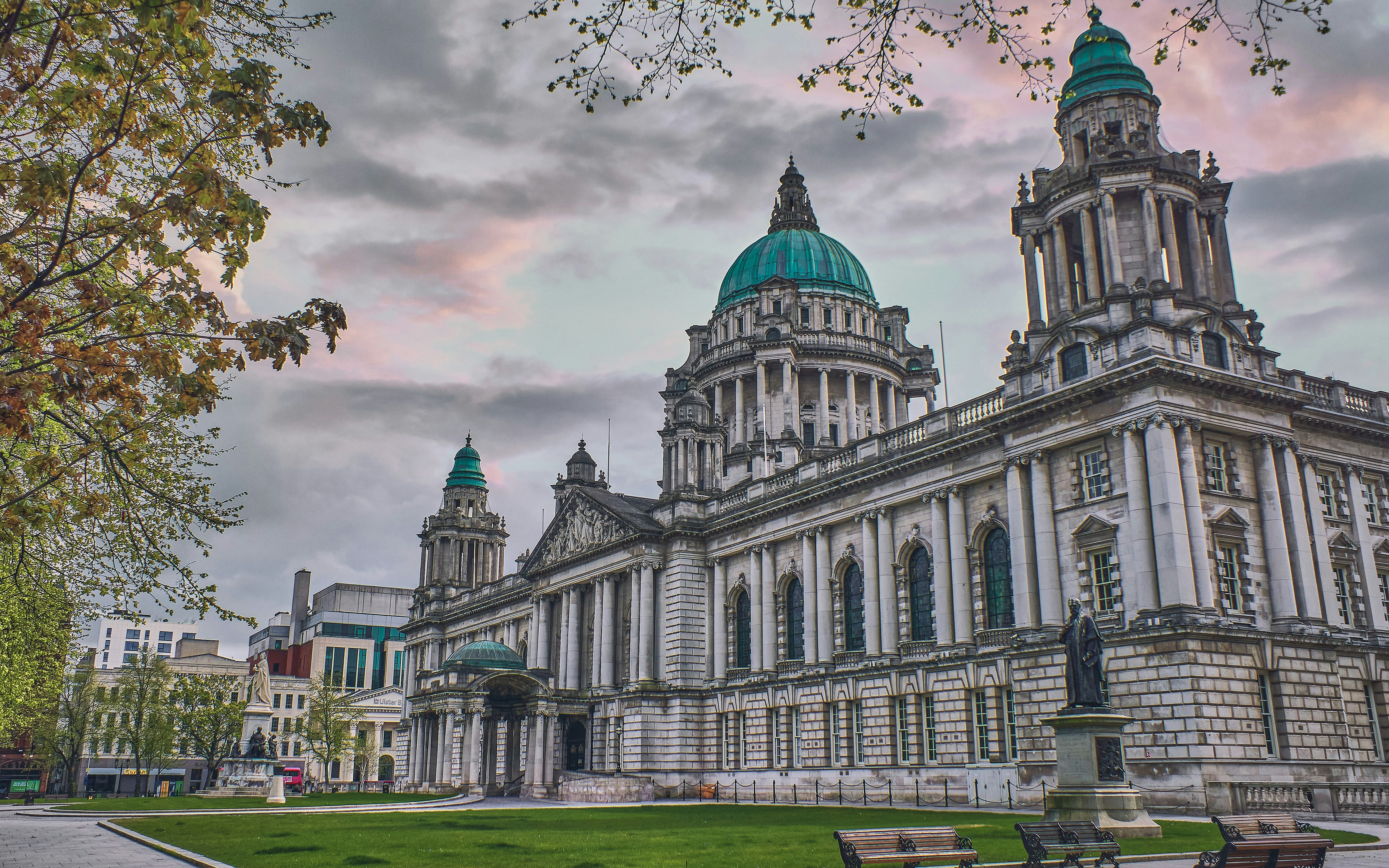
About Whitehaven
About Douglas
The Isle of Man, situated in the Irish Sea off the west coast of England, is a mountainous, cliff-fringed island and one of Britain’s most beautiful spots. Measuring just 30 miles by 13 miles, the Isle of Man remains semi-autonomous. With its own postage stamps, laws, currency, and the Court of Tynwald (the world’s oldest democratic parliament), the Isle of Man is rich with history and lore.Inhabited from Neolithic times, the island became a refuge for Irish missionaries after the 5th Century. Norsemen took the island during the 9th Century and sold it to Scotland in 1266. However, since the 14th Century, it has been held by England. Manx, the indigenous Celtic language, is still spoken by a small minority. The Isle of Man has no income tax, which has encouraged many Britains to regard the island as a refuge. Otherwise, it is populated by Gaelic farmers, fishermen, and the famous tailless manx cats. The varied landscape features austere moorlands and wooded glens, interspersed by fine castles, narrow-gauge railways, and scores of standing stones with Celtic crosses. The hilly terrain rises to a height of 2,036 feet at Mount Snaefell, which dominates the center of the island.
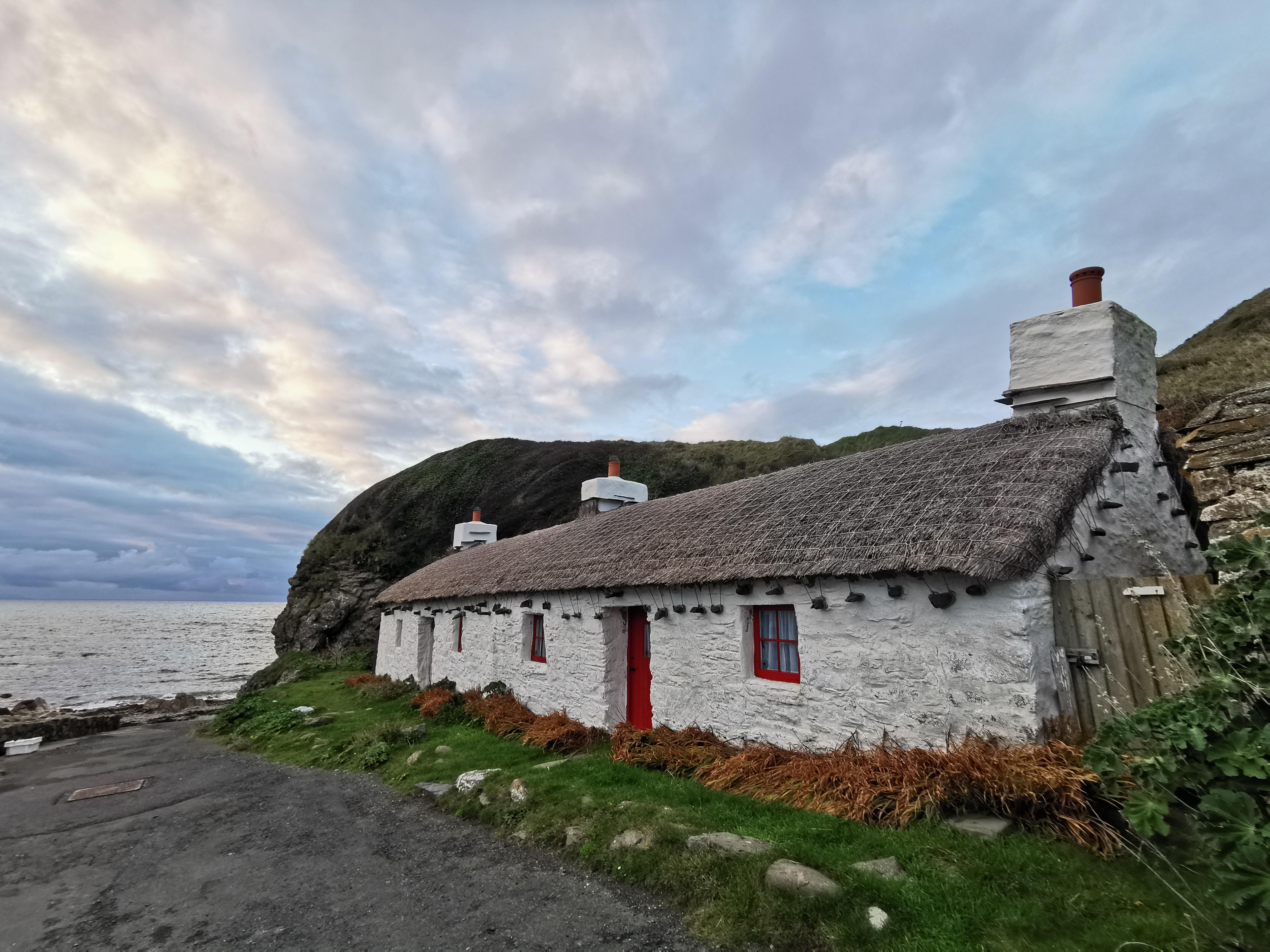
About Warrenpoint
About Dublin
Dublin is making a comeback. The decade-long "Celtic Tiger" boom era was quickly followed by the Great Recession, but The Recovery has finally taken a precarious hold. For visitors, this newer and wiser Dublin has become one of western Europe's most popular and delightful urban destinations. Whether or not you're out to enjoy the old or new Dublin, you'll find it a colossally entertaining city, all the more astonishing considering its intimate size.It is ironic and telling that James Joyce chose Dublin as the setting for his famous Ulysses, Dubliners, and A Portrait of the Artist as a Young Man because it was a "center of paralysis" where nothing much ever changed. Which only proves that even the greats get it wrong sometimes. Indeed, if Joyce were to return to his once-genteel hometown today—disappointed with the city's provincial outlook, he left it in 1902 at the age of 20—and take a quasi-Homeric odyssey through the city (as he so famously does in Ulysses), would he even recognize Dublin as his "Dear Dirty Dumpling, foostherfather of fingalls and dotthergills"?For instance, what would he make of Temple Bar—the city's erstwhile down-at-the-heels neighborhood, now crammed with cafés and trendy hotels and suffused with a nonstop, international-party atmosphere? Or the simple sophistication of the open-air restaurants of the tiny Italian Quarter (named Quartier Bloom after his own creation), complete with sultry tango lessons? Or of the hot–cool Irishness, where every aspect of Celtic culture results in sold-out theaters, from Once, the cult indie movie and Broadway hit, to Riverdance, the old Irish mass-jig recast as a Las Vegas extravaganza? Plus, the resurrected Joyce might be stirred by the songs of Hozier, fired up by the sultry acting of Michael Fassbender, and moved by the award-winning novels of Colum McCann. As for Ireland's capital, it's packed with elegant shops and hotels, theaters, galleries, coffeehouses, and a stunning variety of new, creative little restaurants can be found on almost every street in Dublin, transforming the provincial city that suffocated Joyce into a place almost as cosmopolitan as the Paris to which he fled. And the locals are a hell of a lot more fun! Now that the economy has finally turned a corner, Dublin citizens can cast a cool eye over the last 20 crazy years. Some argue that the boomtown transformation of their heretofore-tranquil city has permanently affected its spirit and character. These skeptics (skepticism long being a favorite pastime in the capital city) await the outcome of "Dublin: The Sequel," and their greatest fear is the possibility that the tattered old lady on the Liffey has become a little less unique, a little more like everywhere else.Oh ye of little faith: the rare ole gem that is Dublin is far from buried. The fundamentals—the Georgian elegance of Merrion Square, the Norman drama of Christ Church Cathedral, the foamy pint at an atmospheric pub—are still on hand to gratify. Most of all, there are the locals themselves: the nod and grin when you catch their eye on the street, the eagerness to hear half your life story before they tell you all of theirs, and their paradoxically dark but warm sense of humor. It's expected that 2016 will be an extra-special year in the capital, as centenary celebrations of the fateful 1916 Easter Rising will dominate much of the cultural calendar.
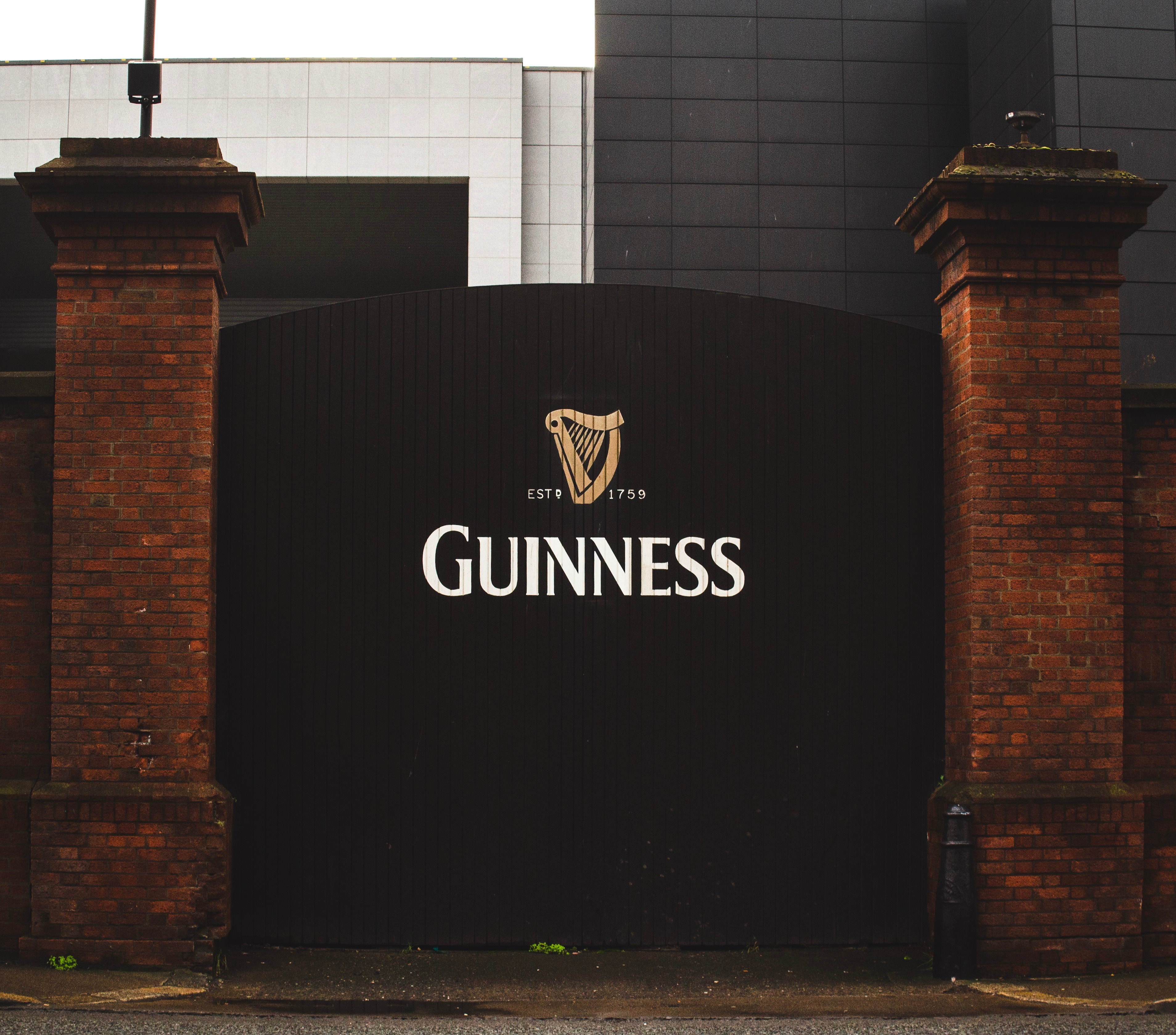
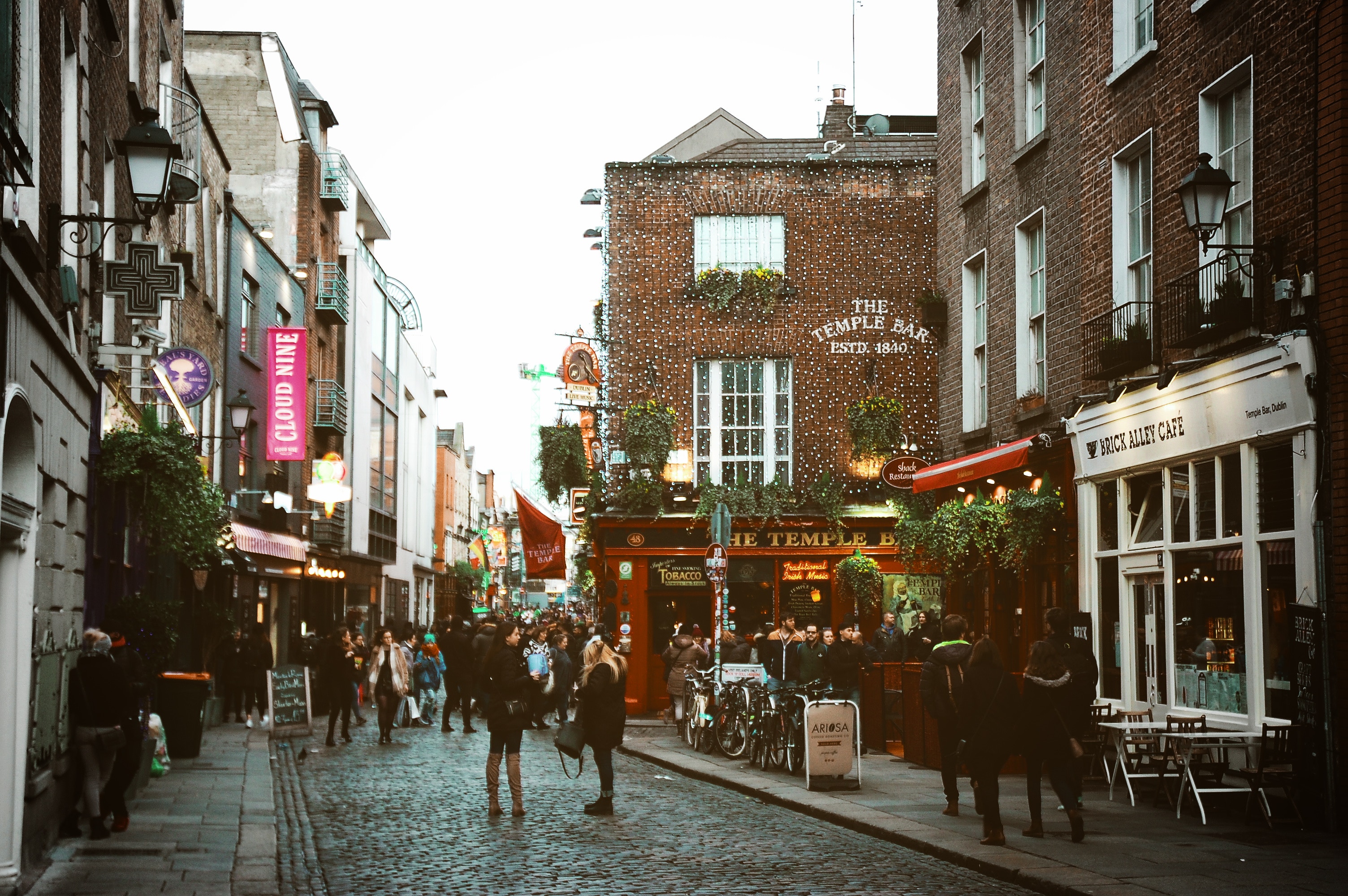

This premium suite (447 sq. ft. / 41.53 sq. meters) includes a thoughtfully appointed separate master bedroom with a permanent queen size bed and a flat-screen TV. The suite features a large master bathroom with a massage shower and a separate soaking tub with views of the sea. A spacious living area with a flat-screen TV, writing desk, and ½ guest bath. There is also a dining area suitable for hosting your friends and family. The Owner’s Suite is suite number 315 on both yachts, located mid-ship on Deck 3 – Close to the pool (aft, deck 3).
Additional Amenities:
- Well-stocked beverage refrigerator
- 2 – 55″ flat-screen TVs with “Infotainment”
- Nespresso® coffee machine
- Direct-dial telephone
- Safe
- Climate Control
- Make-Up Mirror
- Elm Organics bath amenities
- Hair dryer
- Superior Belgian bed & bath linens
- Luxury Bath Robes & Slippers
- Wooden & Padded Silk clothes hangers
- 24-hour in-stateroom “Small Bites” menu
- Wifi Available
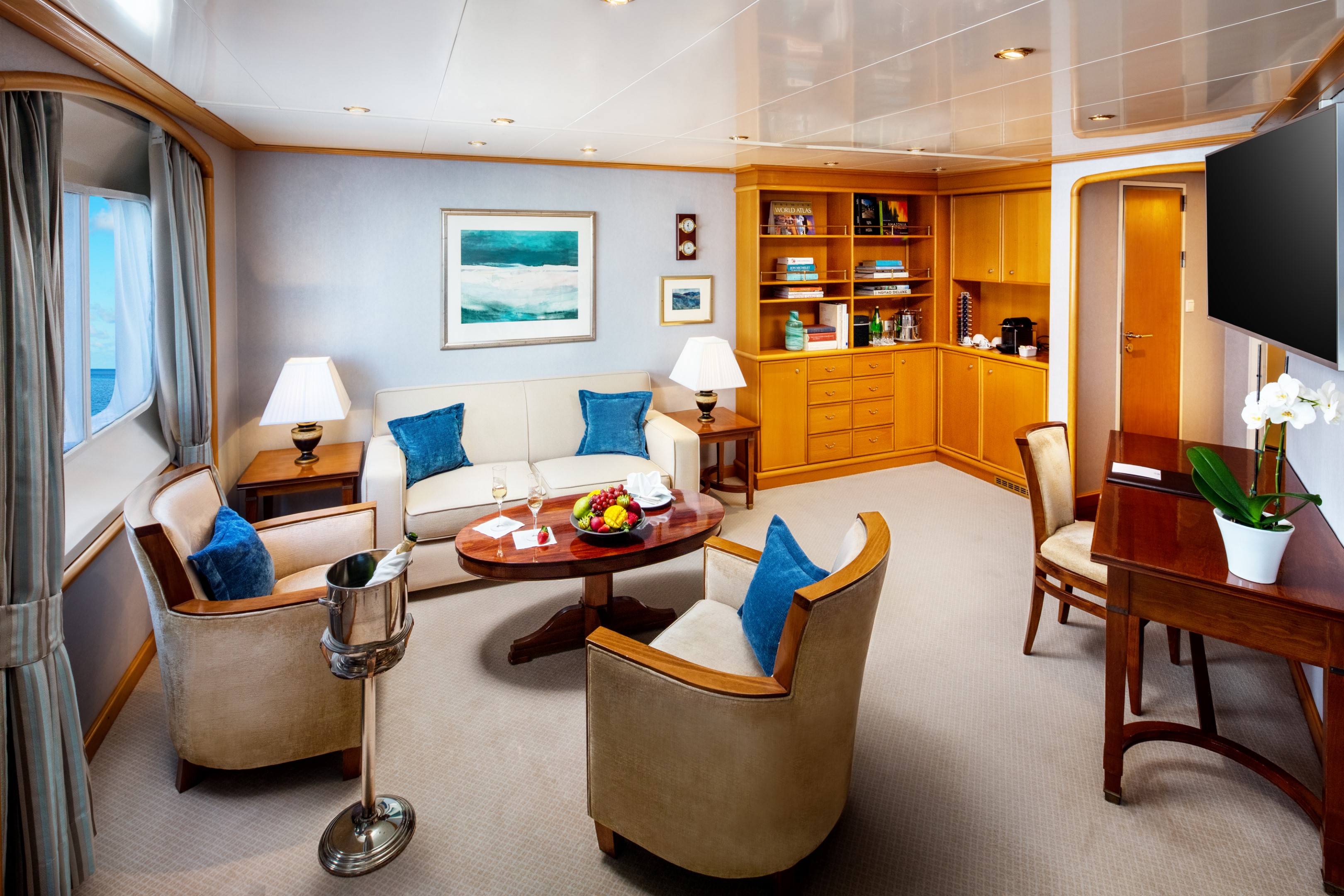
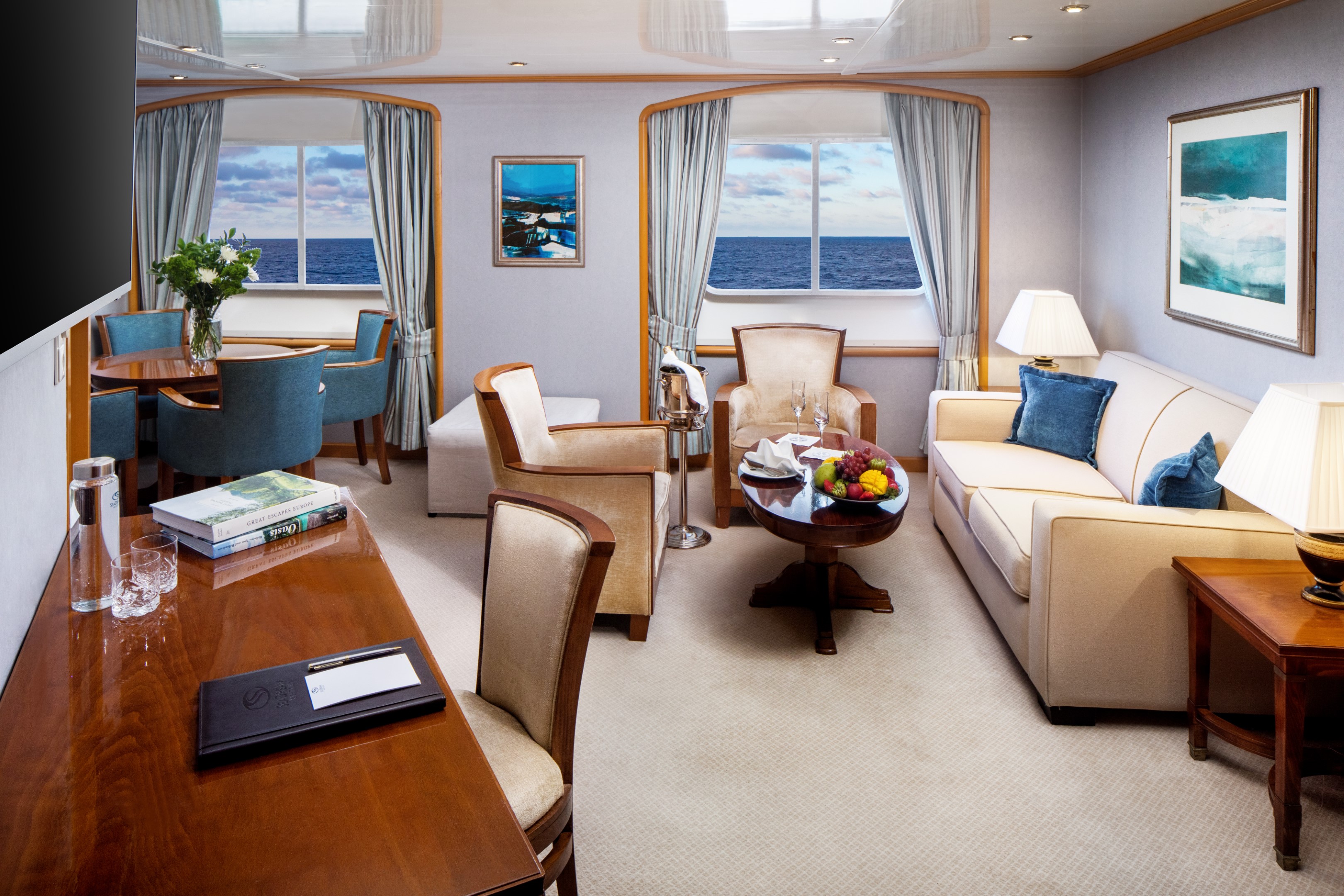
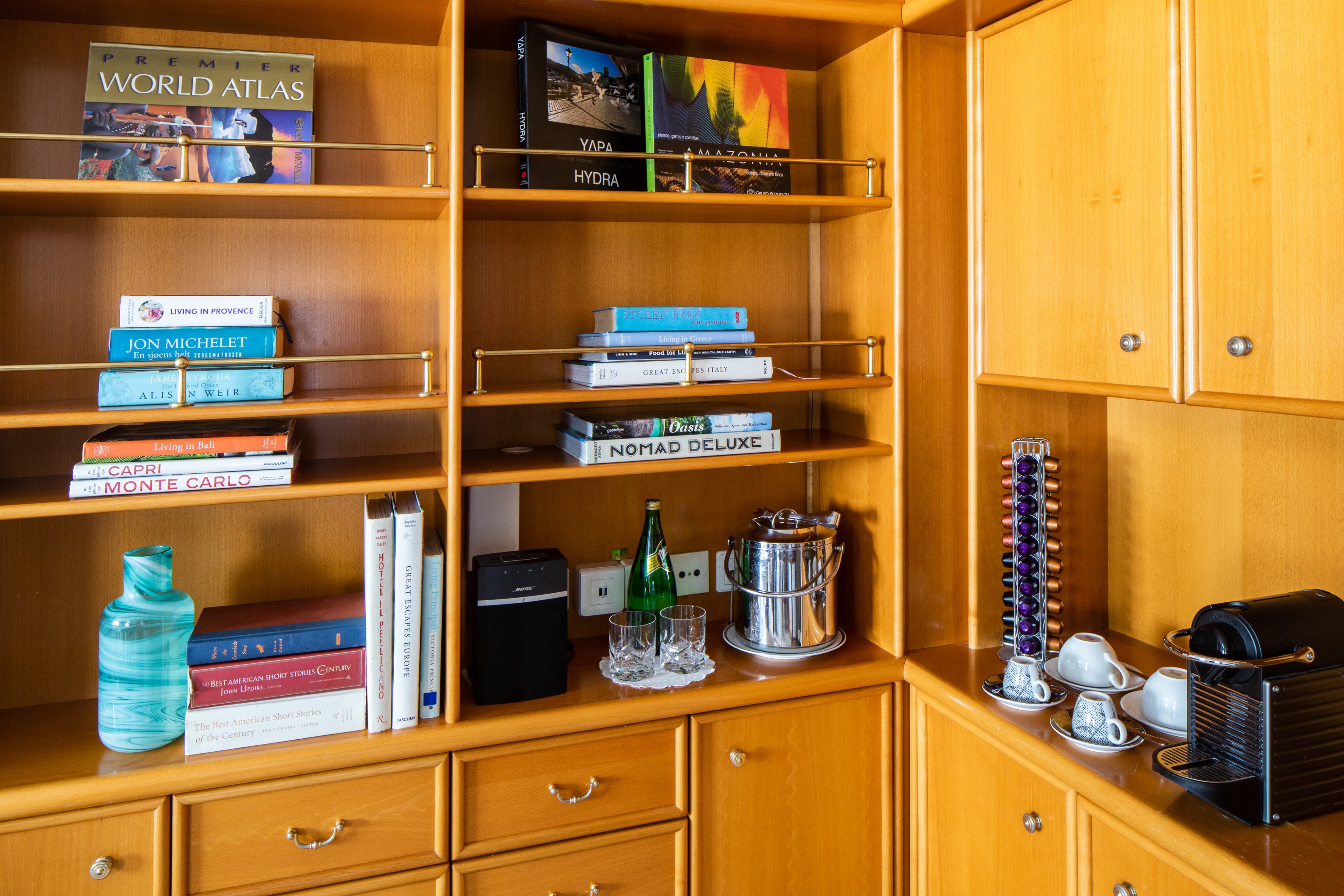
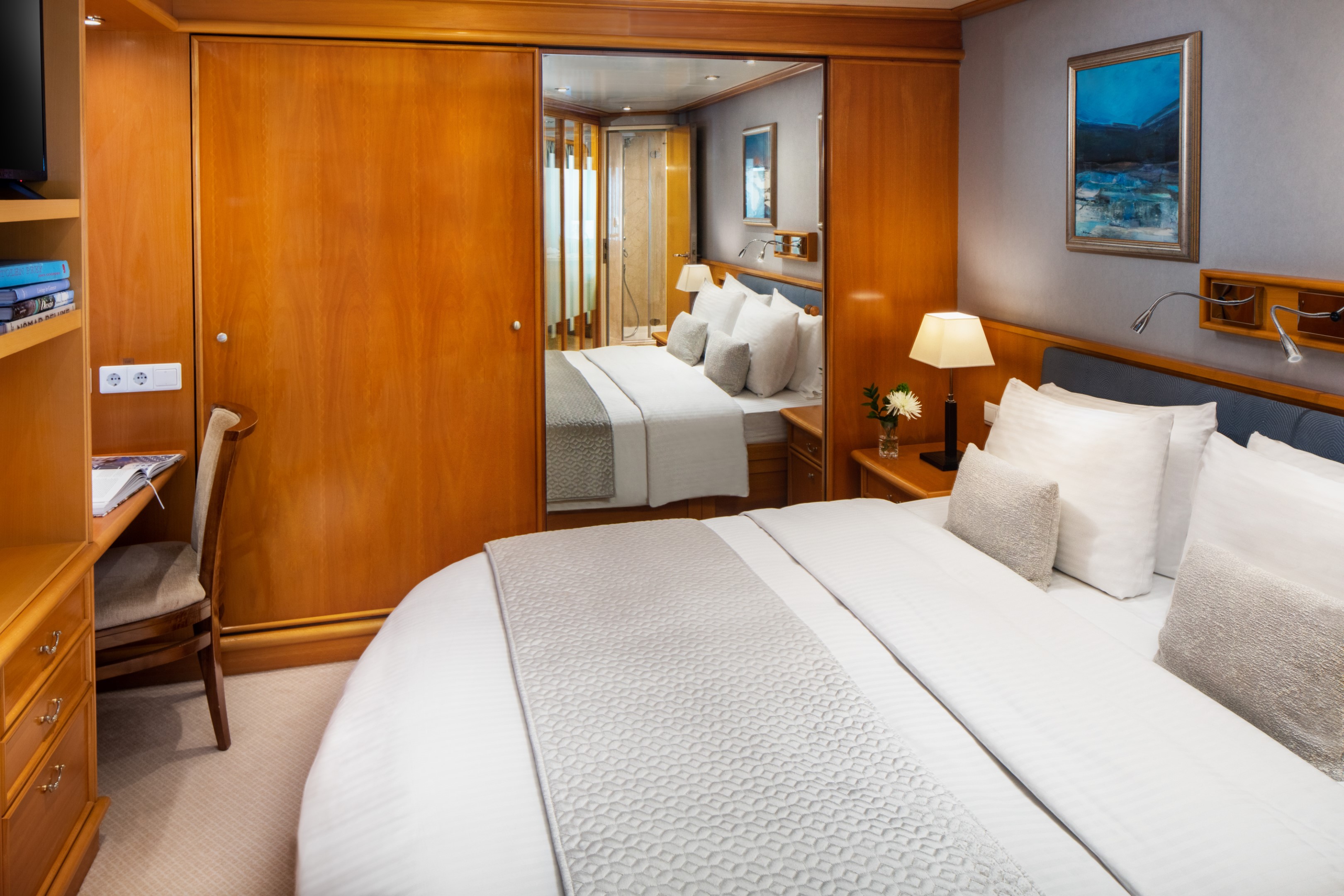
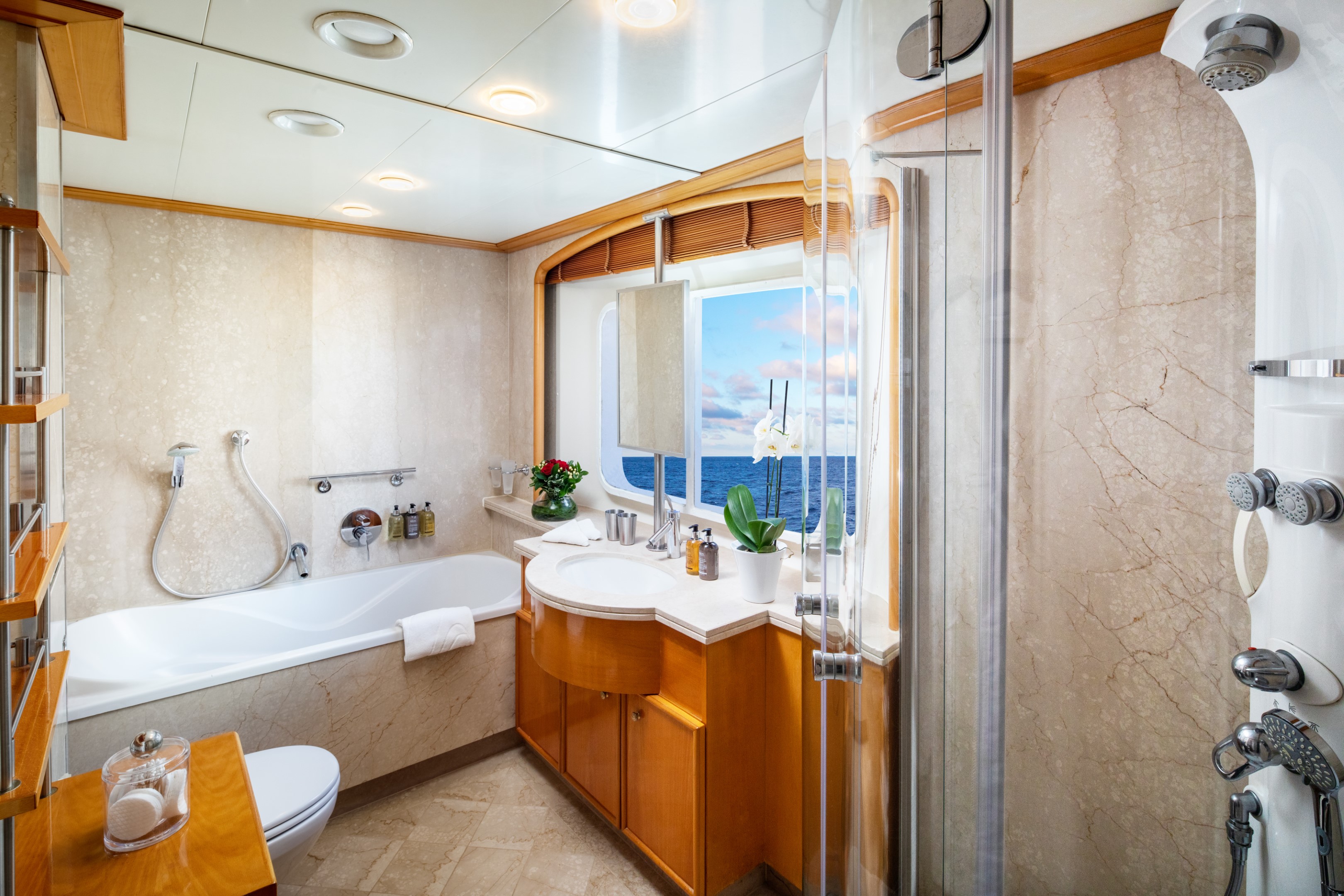
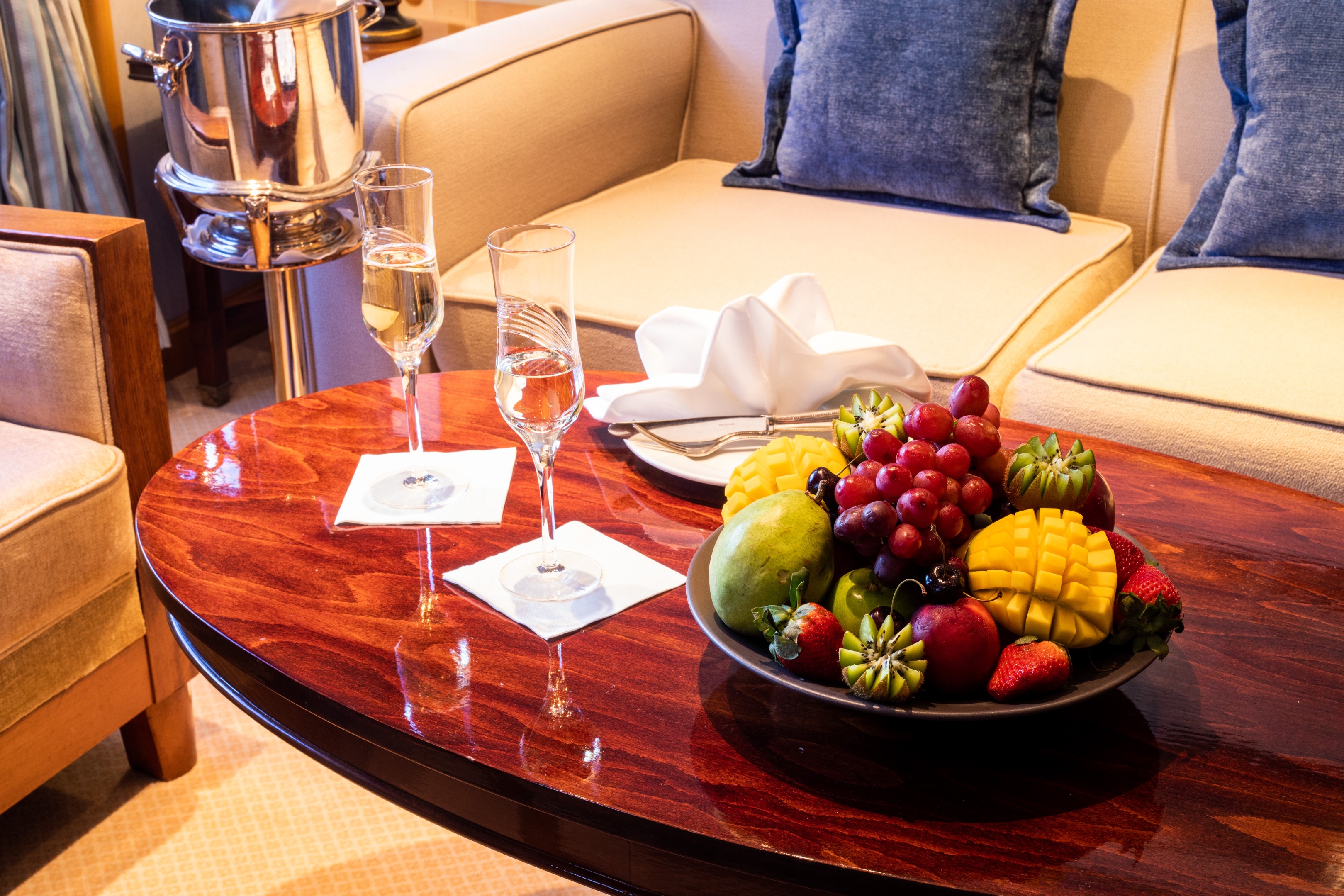
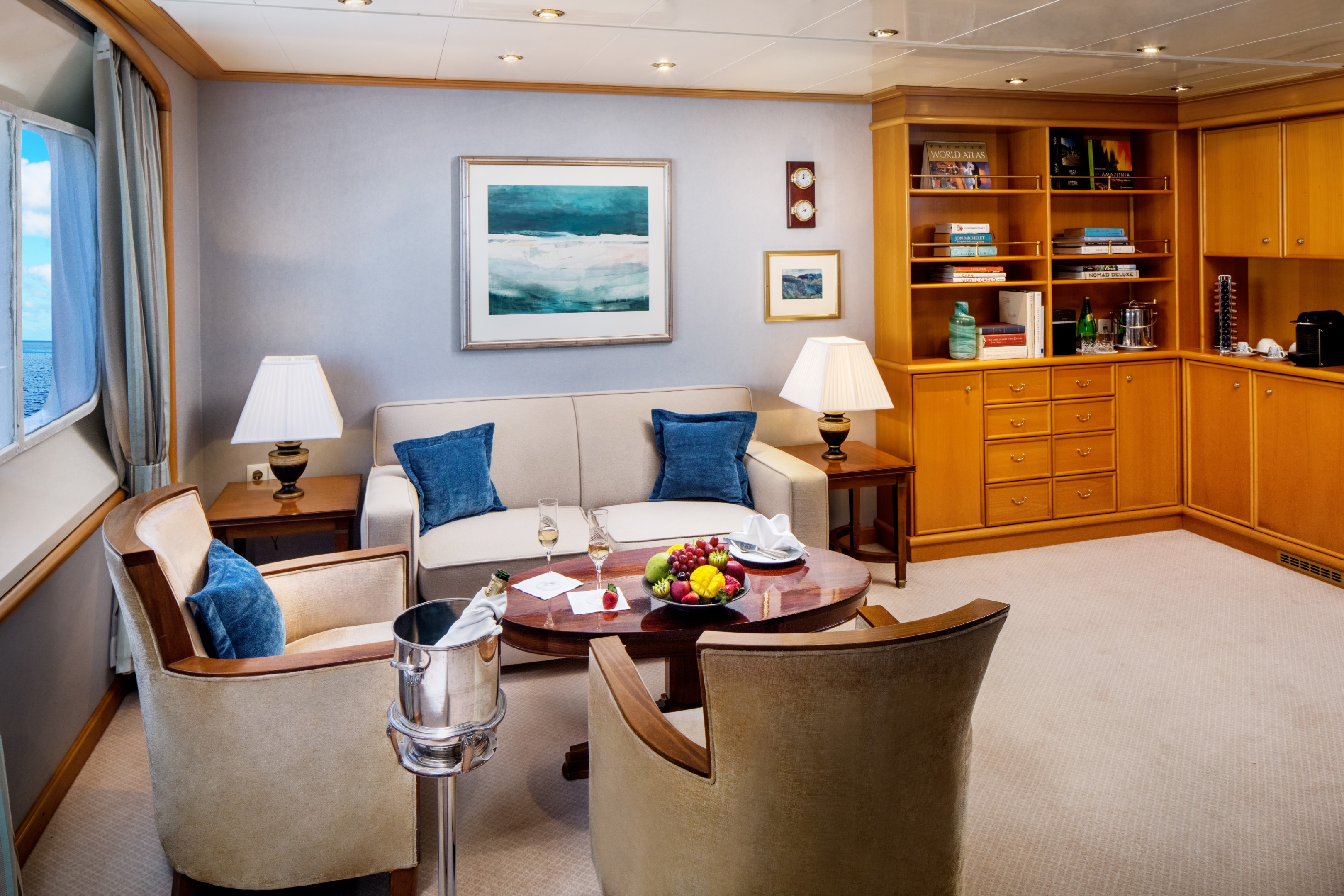
Enjoy 375 sq. ft. / 34.8 sq. meters of living space with ocean views from a total of 3 picture windows. Partitioned living and dining areas with ½ guest bath and closet. Separate and private en-suite master bedroom with permanent queen bed and closet. Marble-lined bathroom with multi-jet shower and soaking tub. Built-in dresser with writing desk. The Admiral Suite is Suite 400 on both yachts and is near the Library.
Additional Amenities:
- Well-stocked beverage refrigerator
- 2 – 55″ flat-screen TVs with “Infotainment”
- Nespresso® coffee machine
- Direct-dial telephone
- Safe
- Climate Control
- Make-Up Mirror
- Elm Organics bath amenities
- Hair dryer
- Superior Belgian bed & bath linens
- Luxury Bath Robes & Slippers
- Wooden & Padded Silk clothes hangers
- 24-hour in-stateroom “Small Bites” menu
- Wifi Available
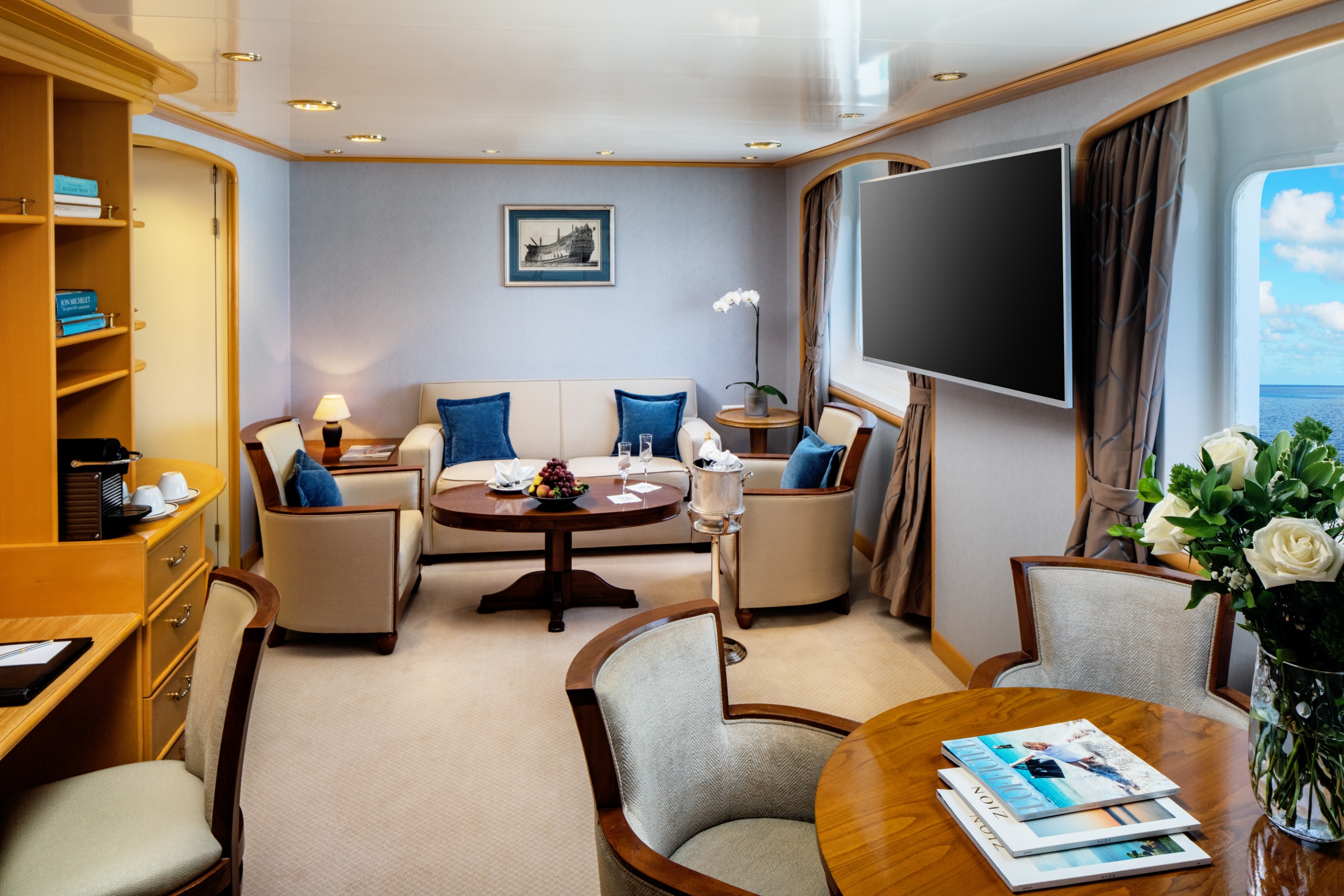
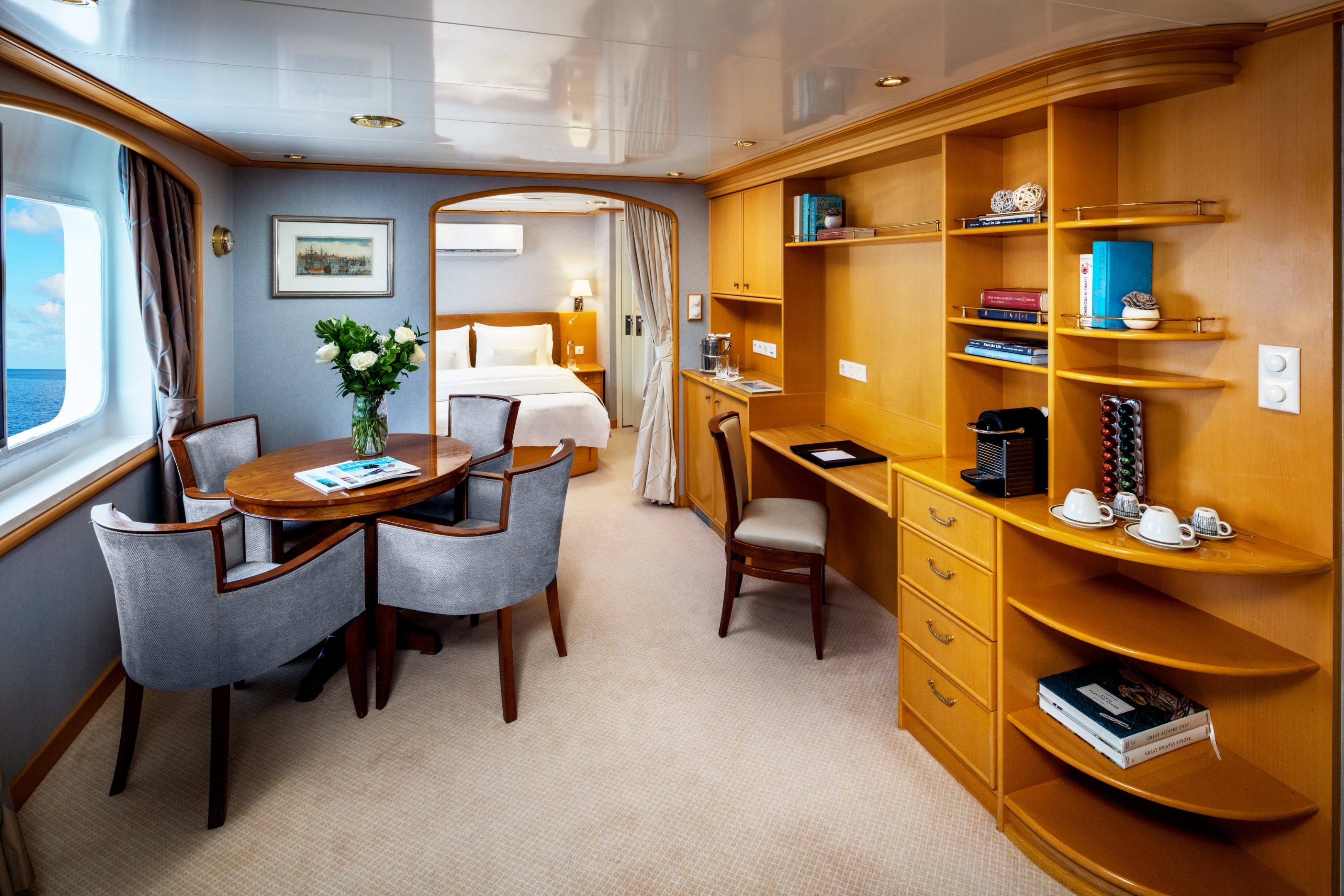
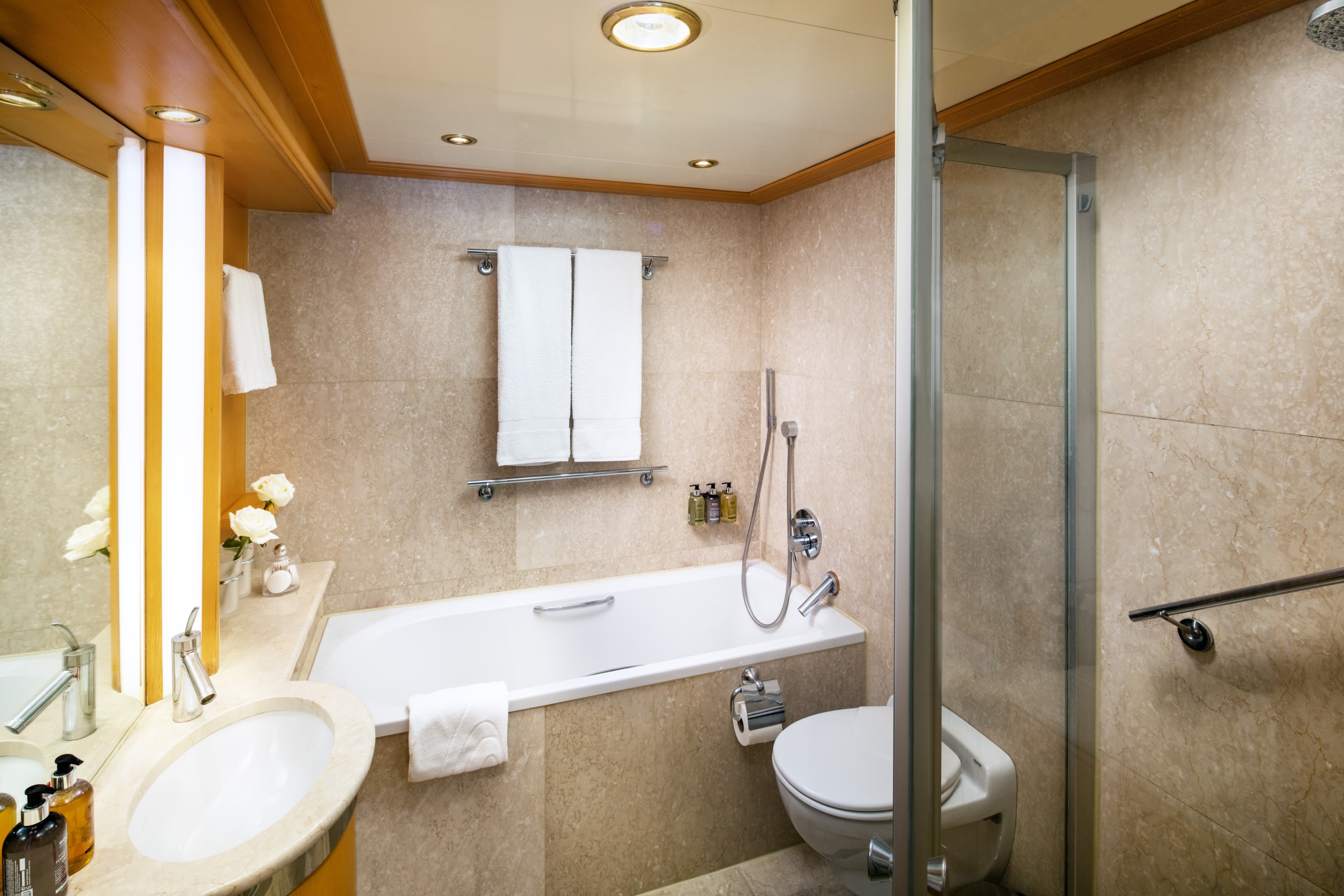
We combine two Yacht Club Staterooms to create a beautiful and spacious Commodore Suite. These comfortably appointed ocean-view suites provide a choice of two twin beds or a queen-size bed, two full marble-lined bathrooms with multi-jet showers, a seating area with sofa, coordinated chair and cocktail table, 2 spacious closets, and built-in dressers with writing desk. Configuration allows for either an additional permanent queen bed or dining area. There are eight possible Commodore Suites and they average 390 spacious sq. ft. / 36.23 sq. meters. Commodore Suites on Deck 2 feature four (4) 17” round windows instead of 2 picture windows found in Deck 3 Commodore Suites. Deck 3 Commodore Suites are close to the Pool and Main Salon.
Additional Amenities:
- Well-stocked beverage refrigerator
- 2 – 55″ flat-screen TVs with “Infotainment”
- Direct-dial telephone
- Safe
- Climate Control
- Make-Up Mirror
- Hair dryer
- Elm Organics bath amenities
- Superior Belgian bed & bath linens
- Luxury Bath Robes & Slippers
- Wooden & Padded Silk clothes hangers
- 24-hour in-stateroom “Small Bites” menu
- Wifi Available
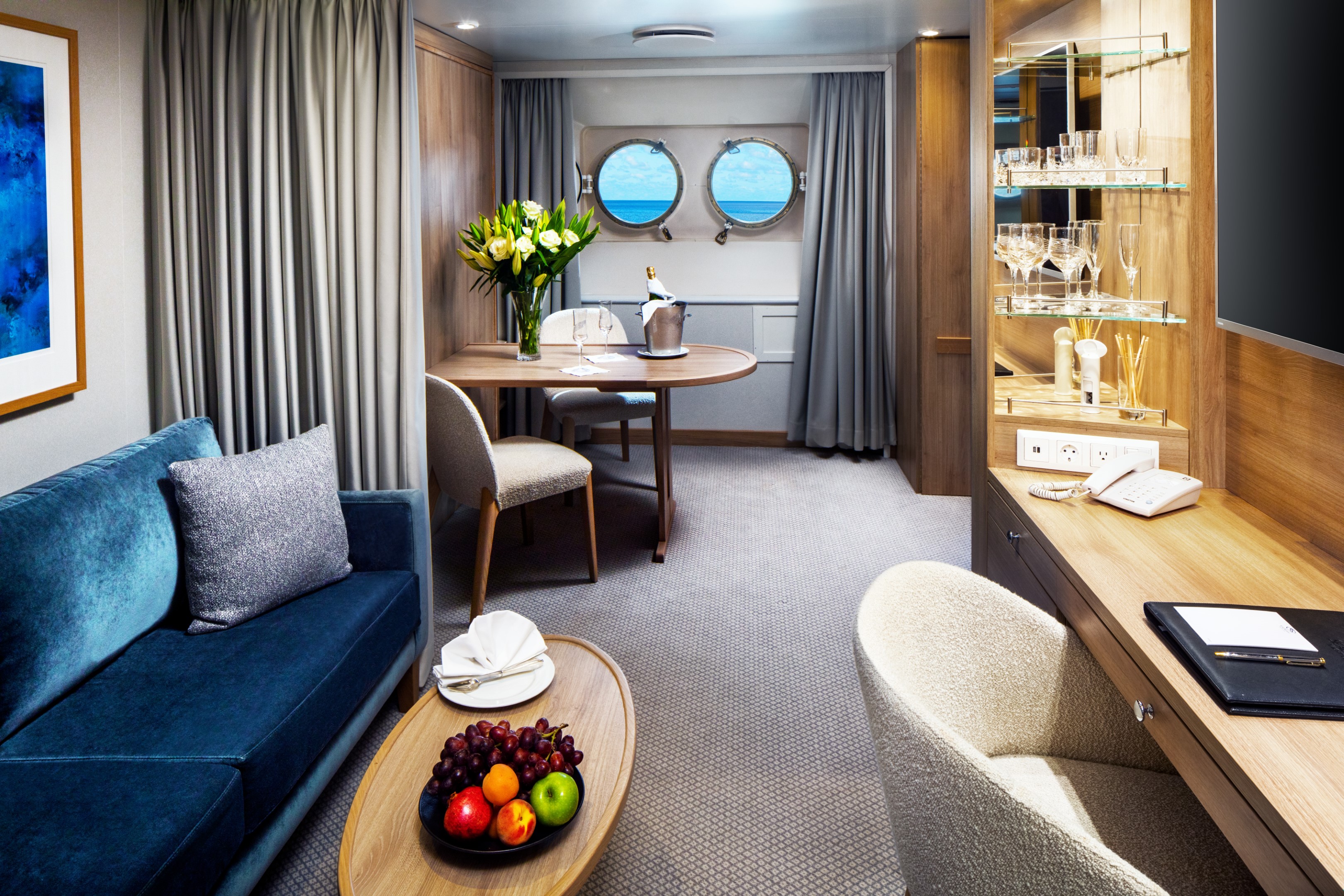
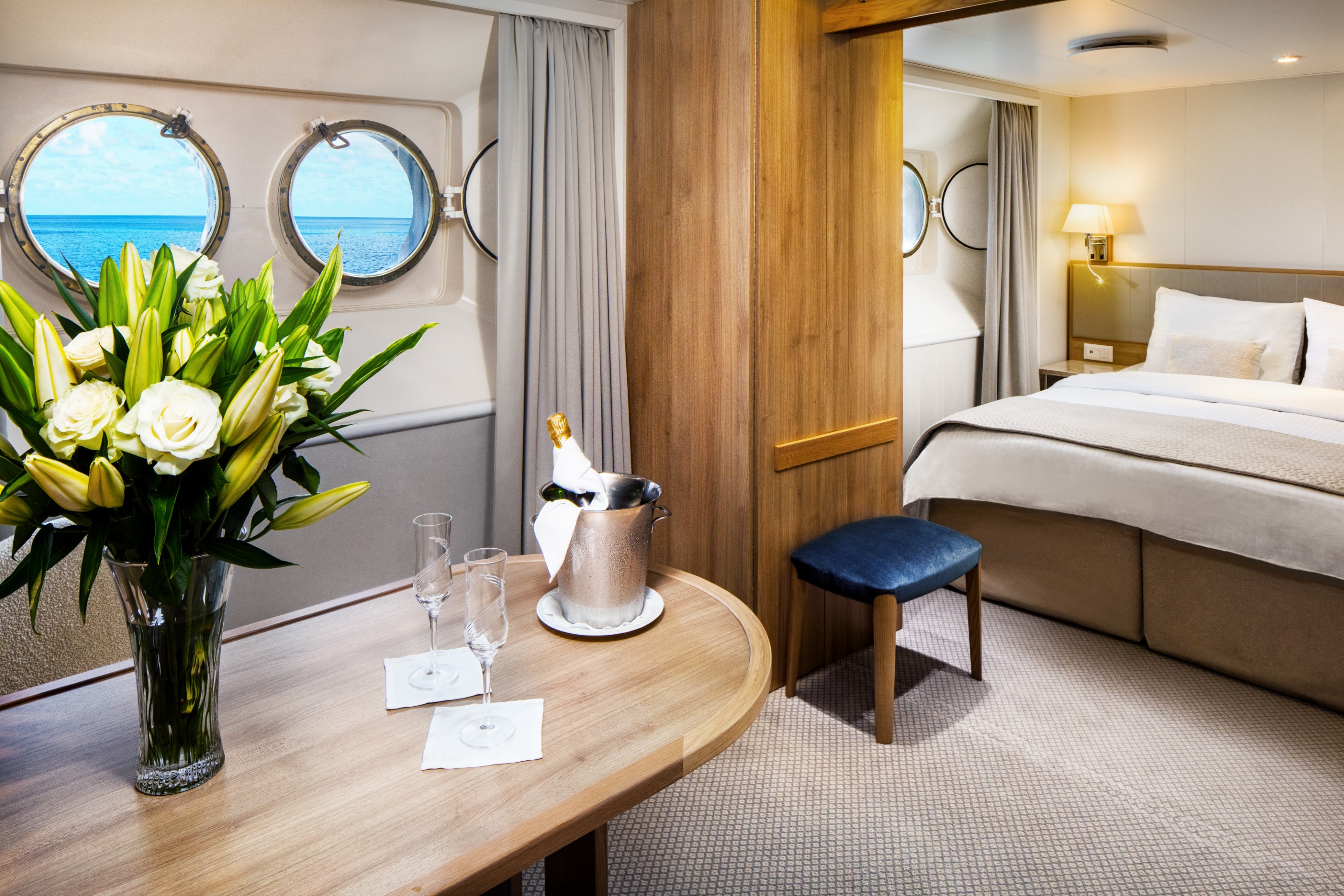
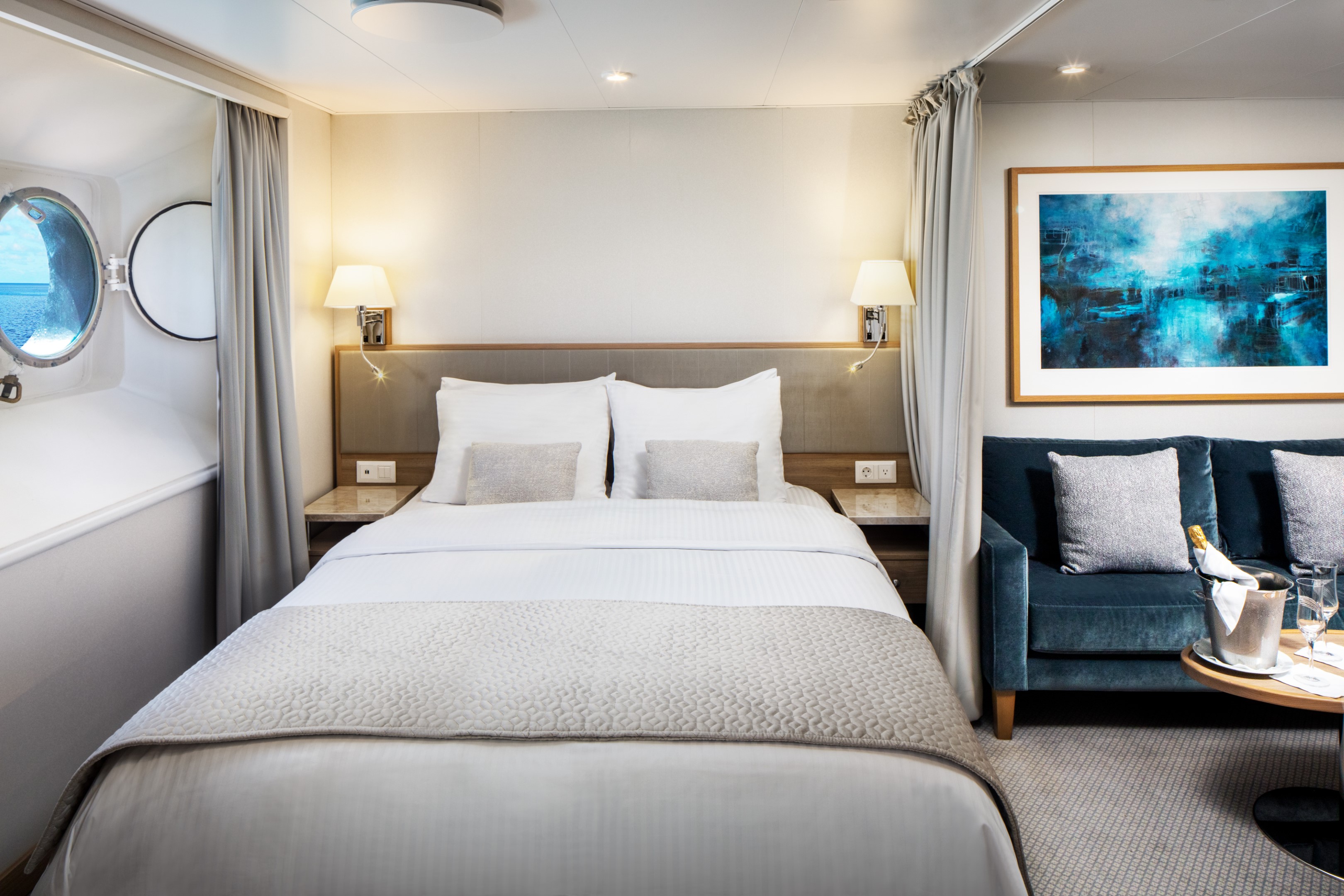
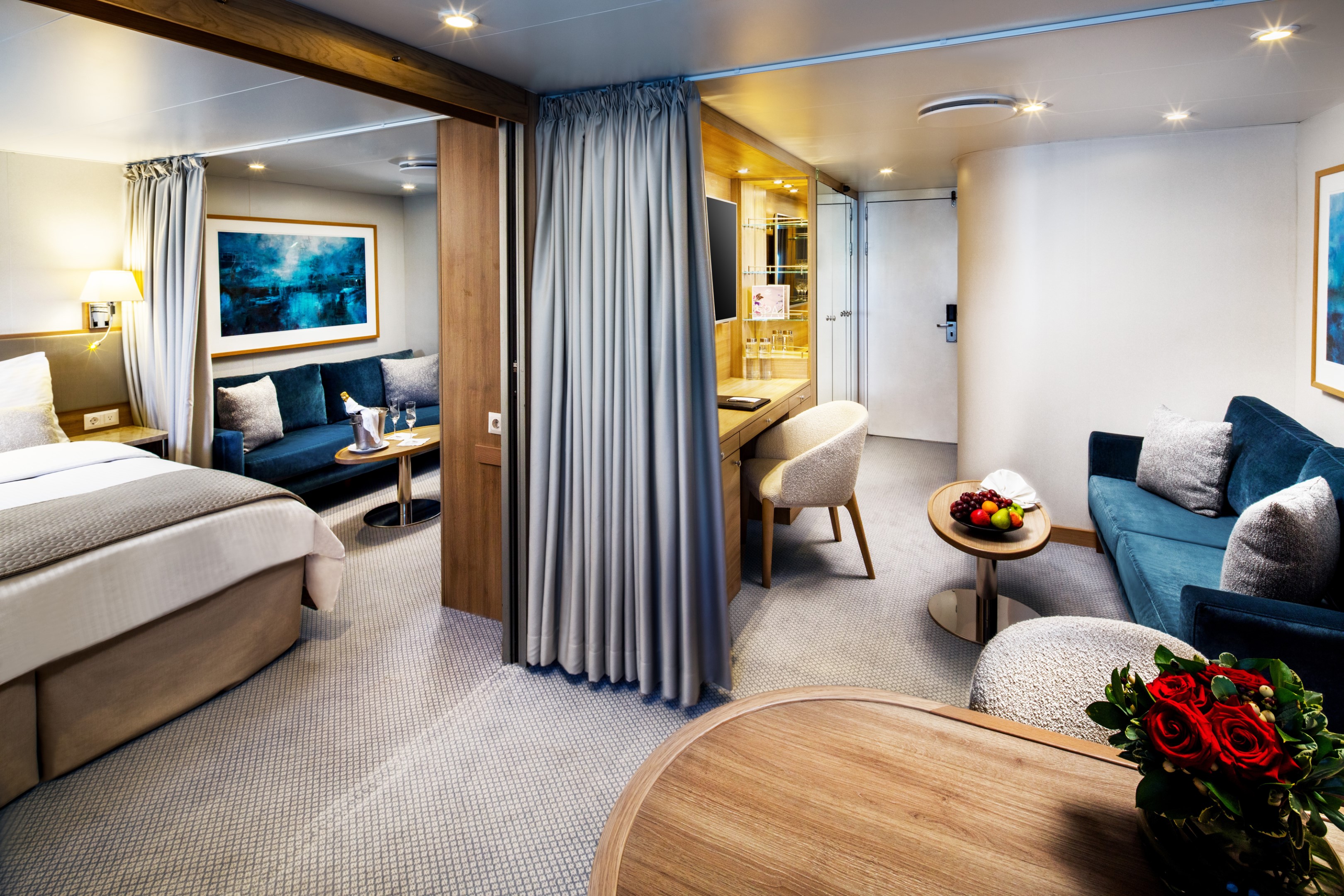
Yacht Club Deck 3 & 4 staterooms average 195 sq.ft./18.12 sq. meters. These picture window ocean view staterooms include a marble-lined bathroom in select staterooms with a multi-jet shower and a well-appointed open living area with sofa, chair, cocktail table, and built-in dresser with writing desk. Most staterooms offer a choice of 2 twin beds or 1 queen bed. Please contact the reservations team to confirm your choice. Deck 4 staterooms enjoy close proximity to the SeaDream Spa, Fitness Centre, and Library. Deck 3 is the perfect location for guests who desire to be just feet from the pool.
Additional Amenities:
- Well-stocked beverage refrigerator
- 55″ flat-screen TV with “Infotainment”
- Direct-dial telephone
- Safe
- Climate Control
- Make-Up Mirror
- Hair dryer
- Elm Organics bath amenities
- Superior Belgian bed & bath linens
- Luxury Bath Robes & Slippers
- Wooden & Padded Silk clothes hangers
- 24-hour in-stateroom “Small Bites” menu
- Wifi Available
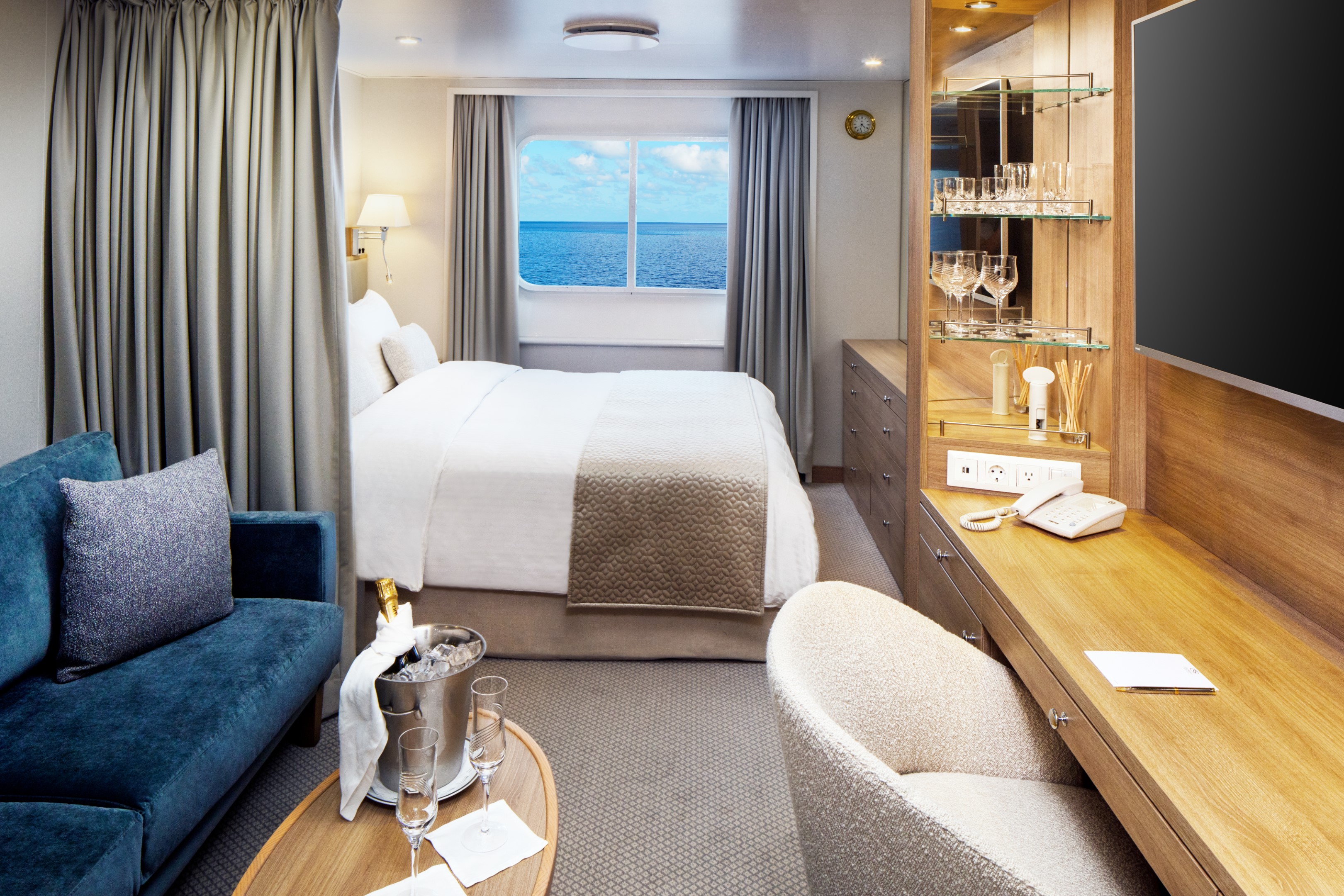
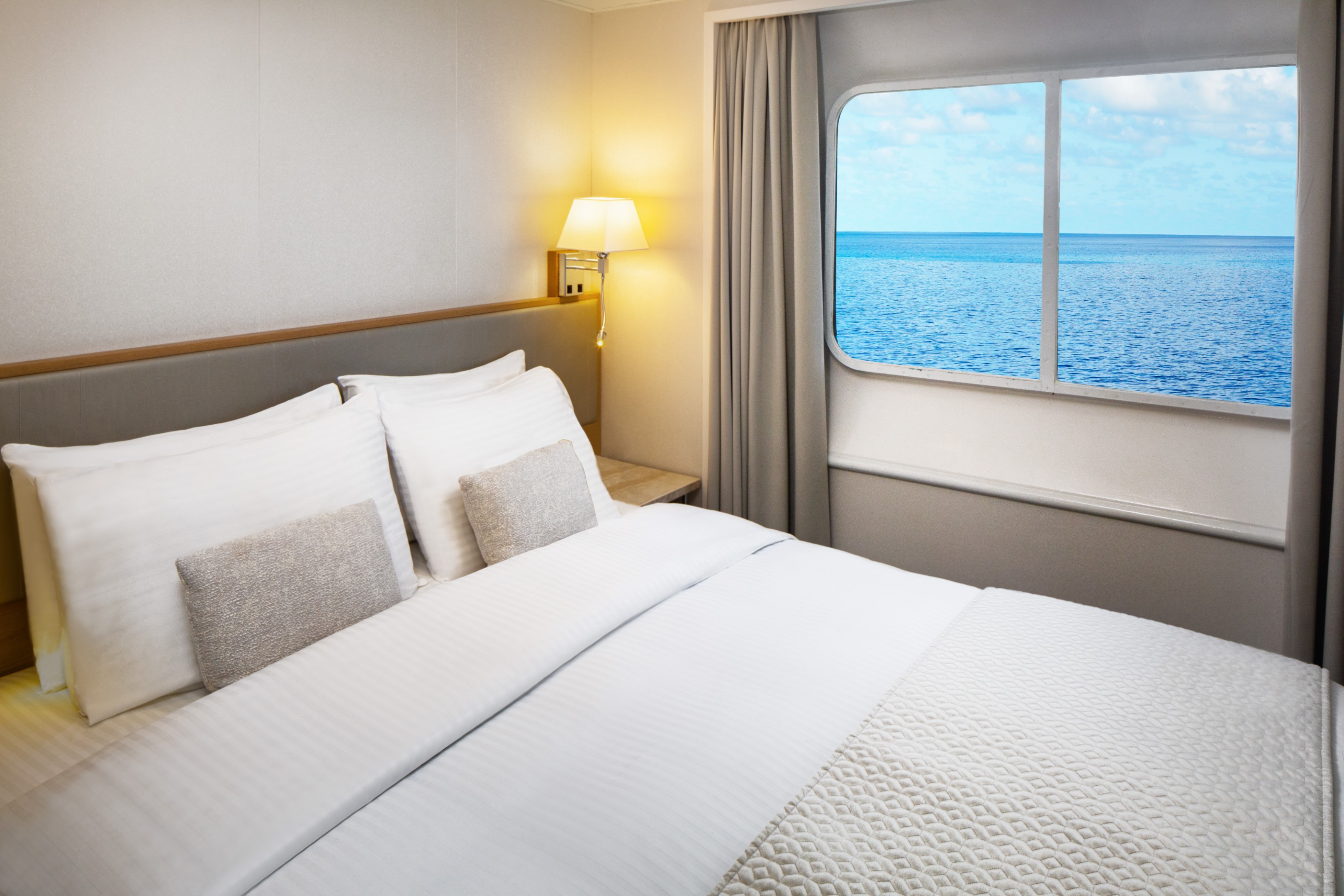
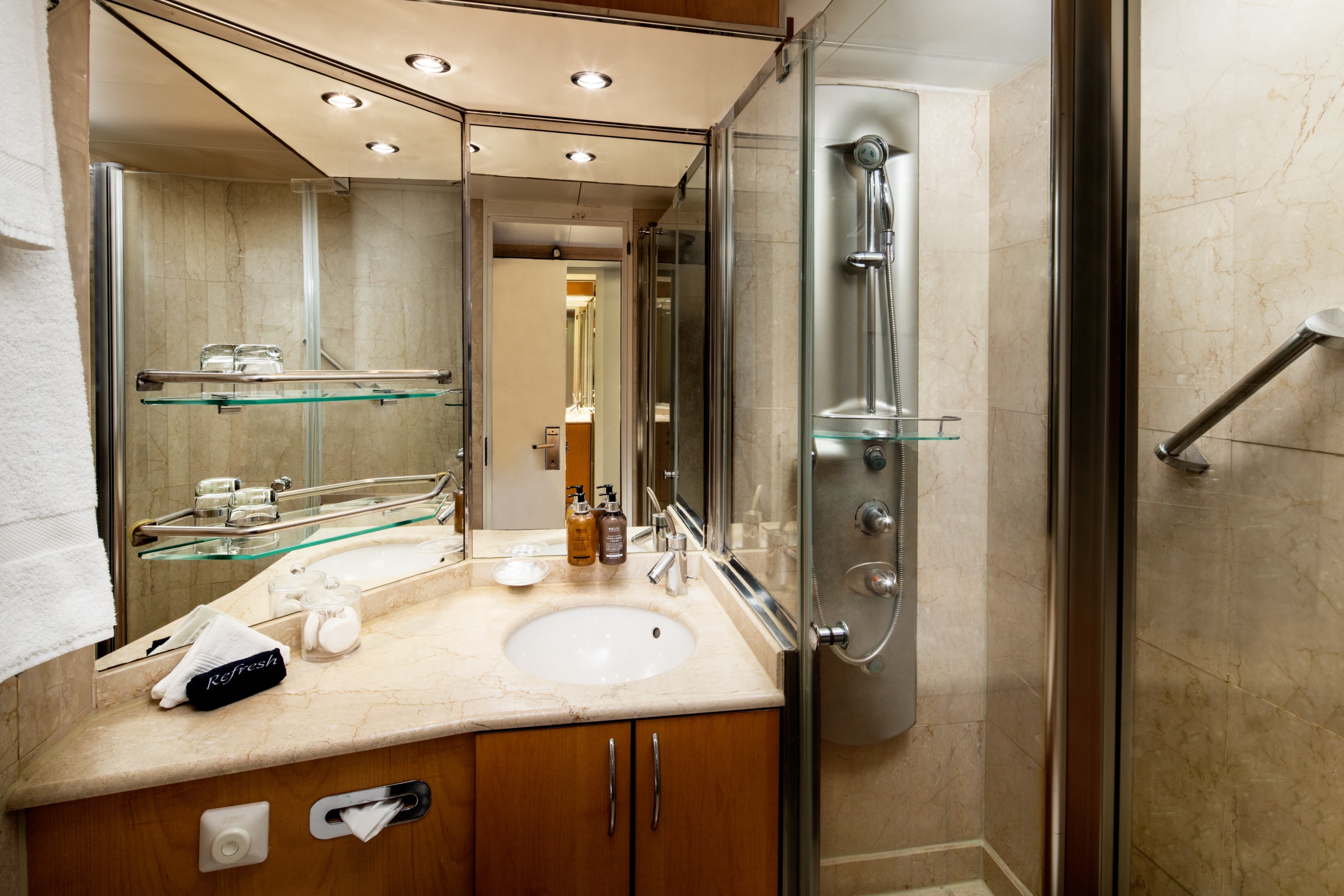
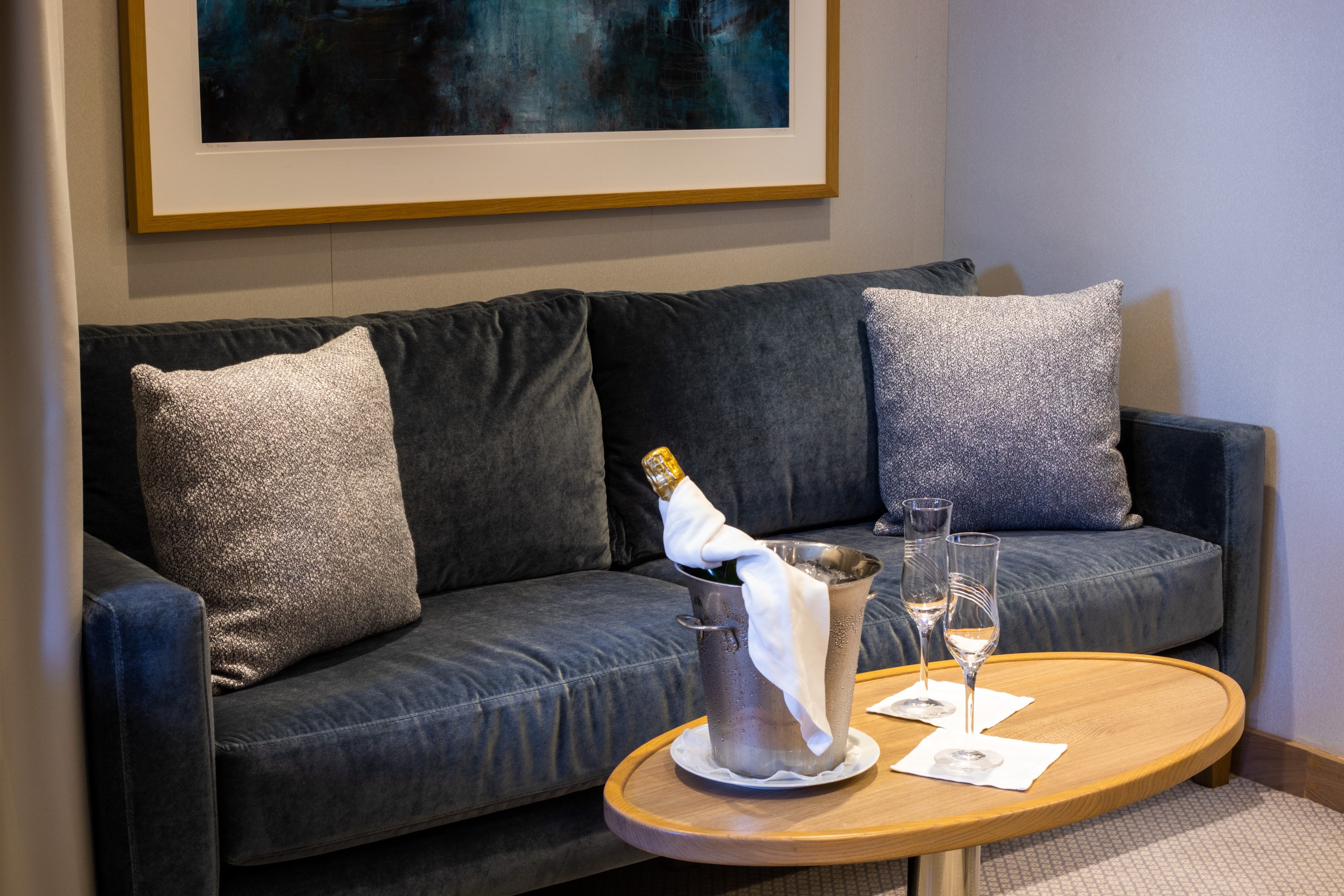
Yacht Club Deck 2 staterooms average 195 sq.ft./18.12 sq. meters. These ocean view staterooms include a marble-lined bathroom in select staterooms with a multi-jet shower and a well-appointed open living area with sofa, chair, cocktail table, built-in dresser with writing desk, and ample closet space. Most staterooms offer a choice of 2 twin beds or 1 queen bed. Please contact the reservations team to confirm your choice. Yacht Club Deck 2 staterooms feature two (2) 17” round windows instead of a picture window.
Additional Amenities:
- Well-stocked beverage refrigerator
- 55″ flat-screen TV with “Infotainment”
- Direct-dial telephone
- Safe
- Climate Control
- Make-Up Mirror
- Hair dryer
- Elm Organics bath amenities
- Superior Belgian bed & bath linens
- Luxury Bath Robes & Slippers
- Wooden & Padded Silk clothes hangers
- 24-hour in-stateroom “Small Bites” menu
- Wifi Available
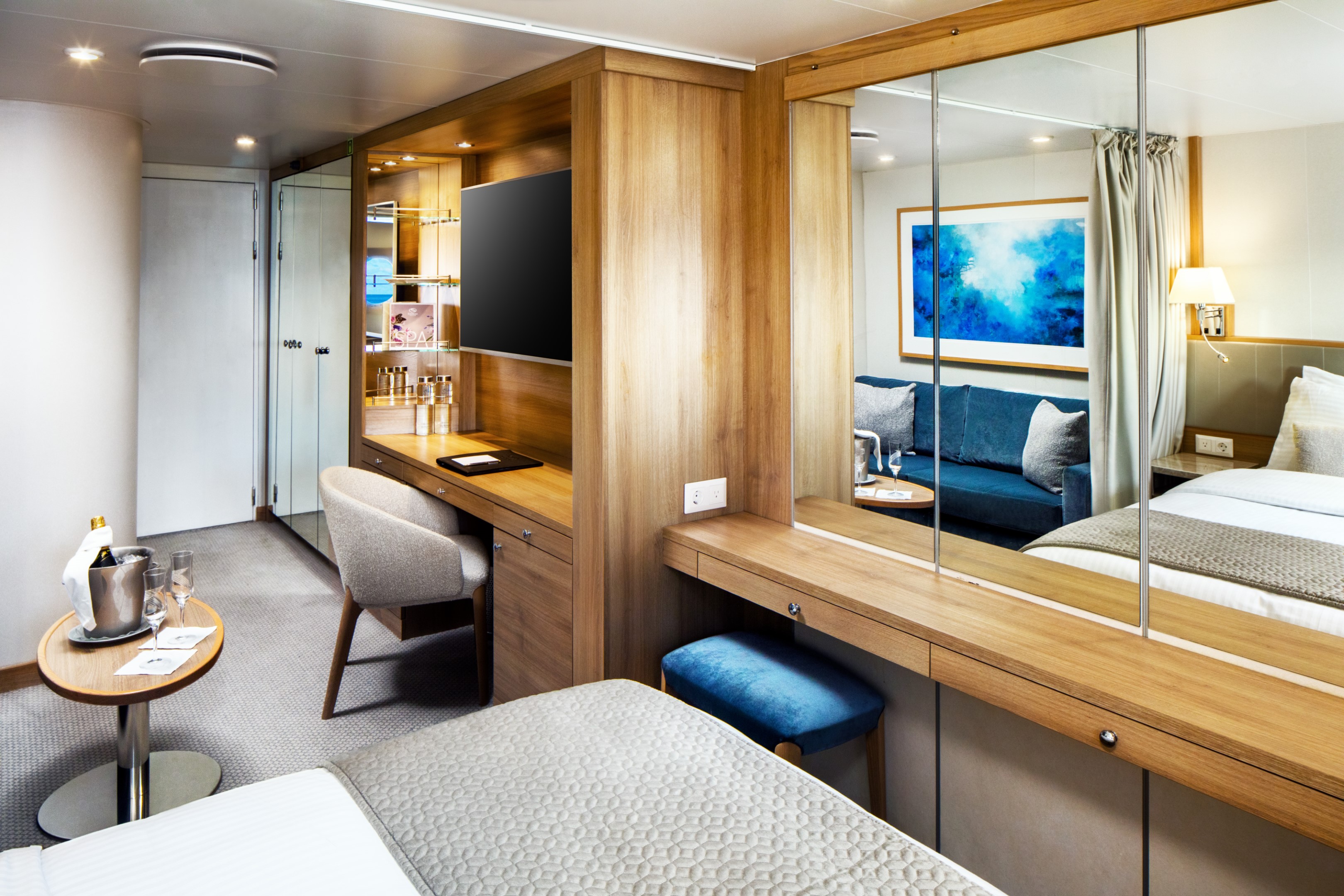


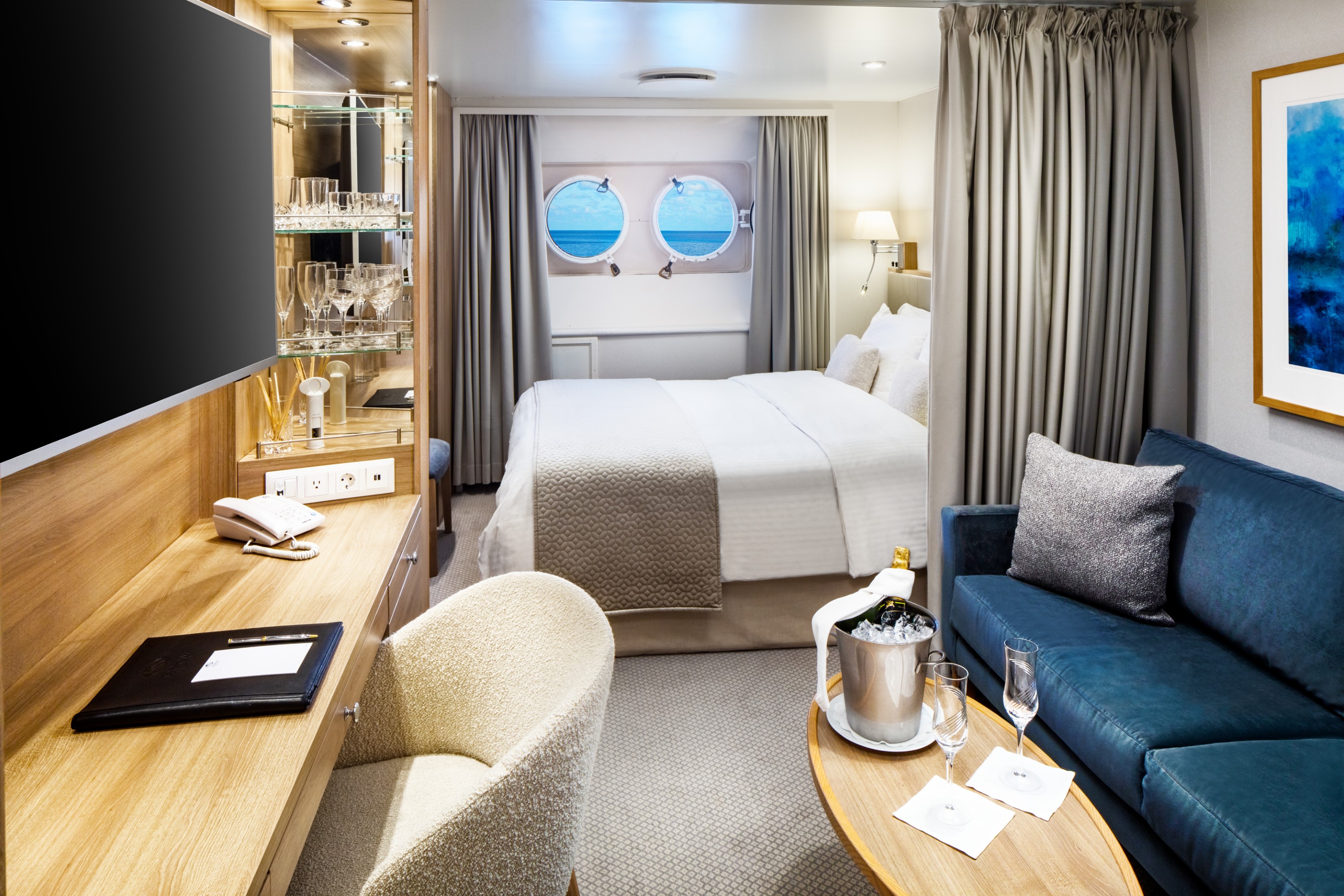
SeaDream I
Named “Best Small Luxury Cruise Ship of 2015” in ForbesLife, twin mega-yachts SeaDream I & II are intimate boutique ships that provide a unique travelling experience unlike any other cruise vacation. The expression “yachting” is not only a statement about size; it’s a lifestyle aboard our intimate vessels with the service of 95 crew members and 112 guests that make each guest feel like they are on their very own private luxury yacht. Chic and stylish, SeaDream’s 56-stateroom yachts are favoured for its elegant informality, highly personal service, inclusive open bar and gratuities, all ocean views staterooms and suites, luxury accommodations and world-class cuisine.
Excellence Begins at Embarkation
We welcome guests with the “SeaDream treatment” from the moment they come aboard. The yachting experience begins with a warm welcome from the captain with cocktails and hors d’oeuvres. The rest is up to you. Whether by day or night lounging on our signature Balinese Dream Beds, indulging in our Dream Cuisine, sipping a SeaDream cocktail at the back of the yacht, relaxing in the SeaDream Spa or being active with our Watersports Marina, this is your yacht, make it uniquely yours.
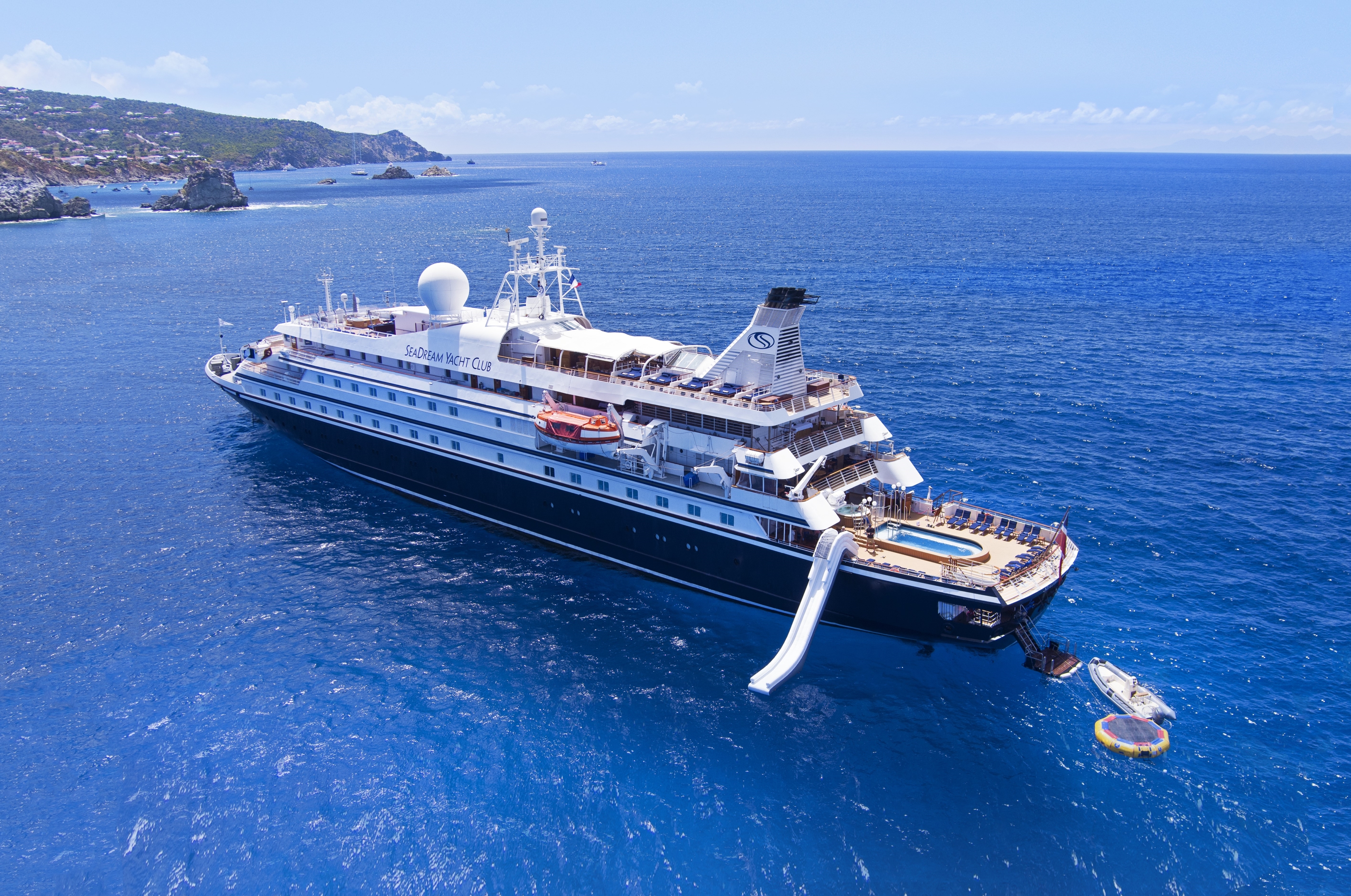
Ship Facts
| Launch Year | 1984 | ||||||||
| Refit Year | 2022 | ||||||||
| Language | en | ||||||||
| Gross Tonnage | 4300 | ||||||||
| Length | 105 | ||||||||
| Width | 14 | ||||||||
| Currency | USD | ||||||||
| Speed | 15 | ||||||||
| Capacity | 112 | ||||||||
| Crew Count | 95 | ||||||||
| Deck Count | 5 | ||||||||
| Cabin Count | 56 | ||||||||
| Large Cabin Count | 0 | ||||||||
| Wheelchair Cabin Count | 0 | ||||||||
| Electrical Plugs |
|
Deck 6
- Balinese Dream Beds
- Top Of The Yacht Bar
- Golf Simulator
- Sun Deck & Sun Beds
- Couples Hot Tubs

Deck 5
- Topside Restaurant
- Medical Facility
- Open Promenade
- Elevator
- Bridge

Deck 4
- Al Fresco Dining & Lounging
- Library
- Piano Bar
- Casino
- Admiral Suite
- SeaDream Spa
- Fitness Centre
- Beauty Salon
- Elevator
- Yacht Club Staterooms
- Admiral Suite

Deck 3
- Pool / Hot Tub
- Pool Bar
- Card Room
- Main Salon / Main Salon Bar
- Concierge & Boutique
- Yacht Club Staterooms
- Commodore Suites
- Owner's Suite

Deck 2
- Retractable Water Sports Platform Marina
- Dining Salon
- Yacht Club Staterooms
- Commodore Suites

A Gastronomical Experience
Experience what wining & dining on your very own yacht would be like with our expert chefs and sommeliers. We are dedicated to offer the best experience possible for each of our guests, including excellent gourmet dishes and the finest wine selection at sea. Our multi-course menu is specially designed with elegant, light portions in mind so that an entire service may be enjoyed, from introductory first courses, to decadent desserts, to expertly paired wines. It’s a gastronomical experience that will have you indulging in every bite. Bon Appétit!
Signature Dream Cuisine
Dining aboard our luxurious yachts is wherever and with whomever you choose. Selections are hand-crafted for every diet and taste, from plant-based meals to perfectly aged steaks and everything in between. All cuisine is prepared a la minute and served al fresco or in the elegant dining salon, with international menus that incorporate local flavours of the region with the freshest, high-quality ingredients and wine lists inspired by your destination. In true yachting style, our dining spaces can accommodate all 112 guests dining together either indoors or al fresco.
Aside from the main menu, SeaDream offers an “Always Available”, à la carte SeaDream selection of favourite cuisine dishes. Dining experiences also include Welcome Aboard cocktails and hors d’oeuvres, daily Early Risers Coffee, Topside Restaurant lunch dining, poolside sandwiches, afternoon snacks, tea service and freshly baked Small-Batch Dream Cookies and pastries. SeaDream’s menus also incorporate gourmet coffees and herbal tea selections, which are available anytime upon request.
Plant-Based & Organic Cuisine
As a pioneer in the living foods movement, we have carefully curated a variety of delicious and nutritious plant-based dishes that showcase the best of local and seasonal ingredients, providing a suite of healthy and sustainable dining choices. Expect a wide range of creative and flavourful vegan dishes, such as freshly prepared salads, hearty soups, flavourful stir-fries, and delectable desserts, all made with sustainable and locally sourced ingredients, including flavours from local farmers’ markets.
Specialty Options
In addition to vegan dining, SeaDream Yacht Club offers a range of other dietary options to cater to various preferences and dietary needs. Whether you are vegetarian, gluten-free, high-protein, or pescatarian, our culinary team is dedicated to ensuring that your dining experience on board is nothing short of exceptional. We even provide guests with Keto-friendly selections to accommodate those with specific dietary requirements.
Topside Restaurant
Indulge in a Signature SeaDream experience with our gourmet 5-star dining, prepared à la minute and served al fresco at the Topside Restaurant.
Aside from the main menu, SeaDream offers an “Always Available”, à la carte SeaDream selection of favourite cuisine dishes. Dining experiences also include Welcome Aboard cocktails and hors d’oeuvres, daily Early Risers Coffee, Topside Restaurant lunch dining, poolside sandwiches, afternoon snacks, tea service and freshly baked Small-Batch Dream Cookies and pastries. SeaDream’s menus also incorporate gourmet coffees and herbal tea selections, which are available anytime upon request.
Dining Salon
Indulge in a Signature SeaDream experience with our gourmet 5-star dining in the elegant Dining Salon. Immerse yourself with delectable flavours with selections like a guest favourite- L’oeuf Poule Au Caviar “Surprise”, succulent lobster, filet mignon, and delectable desserts.
Desert Extravaganza
The voyage of a lifetime deserves the dessert of a lifetime. Our Dessert Extravaganza is an elegant, after dinner gathering. The star of this party is the delectable display of desserts including baked treats, tarts, pies, cakes, ice cream and bananas foster. The perfect end to the perfect day.
An elegant, after dinner gathering. The star of this party is the delectable display of desserts including baked treats, tarts, pies, cakes, ice cream and bananas foster. Your favourite libation, music, fresh ocean air and the twinkle of candles and stars make this the perfect ending to another special SeaDream day
Healthy Corner and Raw & Living Menu
Raw, Vegan & Organic
The only “raw food” or “living food” menu at sea, guests have the option of experiencing an array of dishes prepared only with raw, organic and vegan ingredients, none of which are heated above 118º F. The menu, created in conjunction with the Hippocrates Health Institute even includes dessert options, highlighting light yet indulgent selections. Explore Raw and Living Food onboard Seadream.
Healthy Corner
Create your own healthy dish with our healthy corner. It’s all about choices. Customise your lunch with the following, healthy and organic selections: Alfalfa Sprouts • Fresh Vegetable Crudities • Rocket Lettuce • Lemon Wedges • Raw Capsicum • Raw Broccoli • Raw Cauliflower • Raw Red Radish • Raw Carrot Julienne • Raw Mushroom Slices • Lightly blanched Asparagus • Roasted Pignolias • Roasted pecan Nuts • Roasted Sesame Seeds • Sundried Tomato Tapenade • Black Olive Tapenade • Green Olive Tapenade • Artichoke Tapenade • Organic Olive Oil • Organic Sesame Oil • Braggs Aminos • Tamari
Specialty Options
Aside from the Raw Food Menu, SeaDream’s daily menus include vegetarian and gluten-free selections. Sugar-free options are always available on request. For other dietary needs, guests can consult with SeaDream at any time before the voyage to ensure that we fulfil your special needs.
SeaDream Tea Menu
SeaDream’s tea menu features (12) teas exclusively prepared for SeaDream by a master blender in Kent, United Kingdom. These bold and exciting selections are solely available only onboard. All tea is served in individual “Bodum” 0.51 teapots with plunger tea diffusers and waiters pay special attention to every pot that they serve. When the water is poured, the servers immediately start a timer so that the appropriate time is indicated to each guest upon being served. When the desired time expires, guests can depress the plunger to stop the diffusing process. All tea is served with homemade, gluten-free tea cookies.
Wine & Spirits
Dream gourmet cuisine harmonised with rich and colourful wine flavours enhances the overall gourmet dining experience. Inclusive wine pairings are thoughtfully selected to please your gastronomic palate. An open bar with select brands is available throughout the day, with beverages served upon request anywhere on board, including the Top of the Yacht Bar, featuring 360° views of the surrounding landscapes and seascapes. The Pool Bar offers refreshing beverages throughout the day and the Main Salon is enjoyed by guests for pre-dinner cocktails. After dinner service, the Piano Bar and Casino is a favourite locale for a nightcap.
For our wine connoisseur guests, specially designed Wine Voyages are available in the Mediterranean from May-November. Explore the wonderful flavours and history by immersing yourself with carefully crafted selections of world-renowned wineries, onboard or ashore. Our Wine Director designed these wine voyages exclusively for our SeaDream guests. Wine Voyages include specialised winery visits and land adventures with activities to satisfy the sommelier in you.
Premium Selections
In addition to complimentary wine selections, the SeaDream cellar is stocked with a varied collection from the Old and New World. A wide selection of rare and trendy wines including the Château Ducru Beaucaillou Grand Cru Classé, 2002; and Insignia, Napa Valley, 2006; is available. A premium listing of spirits and concoctions is available, offering a selection of rare whiskeys and cognacs, trendy gins and vodkas, all at attractive prices.
We welcome guests with the “SeaDream treatment” from the moment they come aboard. The yachting experience begins with a warm welcome from the captain with cocktails and hors d’oeuvres. The rest is up to you. Whether by day or night lounging on our signature Balinese Dream Beds, indulging in our Dream Cuisine, sipping a SeaDream cocktail at the back of the yacht, relaxing in the SeaDream Spa or being active with our Watersports Marina, this is your yacht, make it uniquely yours.
By Day
Be splendidly spoiled throughout the day. Signature SeaDream features include our Balinese Dream Beds for lounging at sea and the Watersports Marina Platform where you can enjoy water sports right off the back of the yacht. “Seas the Day” the SeaDream way.
By Night
Music and a lively social atmosphere fills the yacht by night. Enjoy your favorite after dinner cocktail and request a tune at the Piano Bar. Visit the Top of the Yacht Bar for breathtaking night views and mingle with new friends, or try your luck at the Casino on Deck 4. The night is waiting for you on SeaDream.
Starlit Movies®
The pool deck becomes your cinema under the open night sky. Get comfortable in a reclining lounge chair and watch a concert or movie on the outdoor big screen. Your port of call becomes your grand backdrop. Pillows, blankets, fresh popcorn and bar service make this a movie experience like no other.
Casino, Piano Bar & Library
If you’re feeling lucky, begin your evening entertainment with a hand at the Blackjack table in the Casino on Deck 4. Just steps away, enjoy an after dinner drink at the Piano Bar, a relaxed and social lounge area where you enjoy listening to live guitar and piano music. Request your favourite tune and feel free to sing along. Or should you wish for something more quiet, take refuge in the Library. Enjoy a good read from our large selection of books or challenge a fellow yachtsman in a selection of board games. Computer and printer are also available.
Balinese Dream Beds
Take time to watch the world go by on SeaDream’s Signature Balinese Dream Beds. These specially designed beds are the perfect place to catch the views, read a book and sip your favorite beverage. Select a cozy corner of the yacht and take that little catnap you have missed all year. Our comfortable outdoor platform beds are designed with afternoon naps and sunbathing in mind. These thick cushion beds, with throw pillows and individual reclining backs, are the perfect spot on the yacht to stretch out and enjoy unobstructed ocean views and cool sea breezes.
Our signature Balinese Dream beds may be transformed at night to sleep and gaze upon the stars. Curl up in luxurious comfort with plush belgian bed linens and admire the starry night sky on a clear night. The soothing sound of the sea and cozy setting make this a magical, unforgettable experience.
Top of the Yacht Bar
Whether you are the first one to greet the day at the Early Risers Coffee or you enjoy a fine cigar and cognac after dinner, the Top of the Yacht Bar is the social heart of the yacht. Take in the sea breeze and 360° views. Before the sunrise, make your way to the Top of the Yacht Bar to greet the day at the Early Risers Coffee. Throughout the day, you may enjoy your favorite drink or request a special SeaDream cocktail from our expert bartenders. They are perhaps the most loved crew members on board. For those meals in between, order a light bite off the Insuite & Ondeck menu. Gourmet cheese platter anyone?
As day turns to night, enjoy the picturesque sunsets at the Top of the Yacht Bar. The night sky transforms the deck to a memorable night with accompanying music and a social atmosphere. Mingle with friends you meet on board for a night of cocktails, live guitar music, dancing and 360º views of the twinkling stars.
Concierge & Boutique
Our Concierge and Shop Manager are here to assist.
Pool Bar
Where cocktails, iced teas & finger foods abound.
Sun Deck & Sun Beds
Lounge with breathtaking panoramic views.